Search
- Page Path
- HOME > Search
Review
- Colon stenting as a bridge to surgery in obstructive colorectal cancer management
- Dong Hyun Kim, Han Hee Lee
- Received May 23, 2023 Accepted July 29, 2023 Published online March 8, 2024
- DOI: https://doi.org/10.5946/ce.2023.138 [Epub ahead of print]
-
 Abstract
Abstract
 PDF
PDF PubReader
PubReader ePub
ePub - Colonic stent placement is a commonly used bridging strategy for surgery in patients with obstructive colorectal cancer. The procedure involves the placement of a self-expandable metallic stent (SEMS) across the obstructive lesion to restore intestinal patency and alleviate the symptoms of obstruction. By allowing patients to receive surgery in a planned and staged manner with time for preoperative optimization and bowel preparation, stent placement may reduce the need for emergency surgery, which is associated with higher complication rates and poorer outcomes. This review focuses on the role of colon stenting as a bridge to surgery in the management of obstructive colorectal cancer. SEMS as a bridge to surgery for left-sided colon cancer has been demonstrated to be particularly useful; however, further research is needed for its application in cases of right-sided colon cancer. Colon stent placement also has limitations and potential complications including stent migration, re-obstruction, and perforation. However, the timing of curative surgery after SEMS placement remains inconclusive. Considering the literature to date, performing surgery at an interval of approximately 2 weeks is considered appropriate. Therefore, colonic stent placement may be an effective strategy as a bridge to surgery in patients with obstructive colorectal cancer.
- 1,966 View
- 115 Download

Original Article
- Performance comparison between two computer-aided detection colonoscopy models by trainees using different false positive thresholds: a cross-sectional study in Thailand
- Kasenee Tiankanon, Julalak Karuehardsuwan, Satimai Aniwan, Parit Mekaroonkamol, Panukorn Sunthornwechapong, Huttakan Navadurong, Kittithat Tantitanawat, Krittaya Mekritthikrai, Salin Samutrangsi, Peerapon Vateekul, Rungsun Rerknimitr
- Clin Endosc 2024;57(2):217-225. Published online February 7, 2024
- DOI: https://doi.org/10.5946/ce.2023.145

-
 Graphical Abstract
Graphical Abstract
 Abstract
Abstract
 PDF
PDF Supplementary Material
Supplementary Material PubReader
PubReader ePub
ePub 
- Background
/Aims: This study aims to compare polyp detection performance of “Deep-GI,” a newly developed artificial intelligence (AI) model, to a previously validated AI model computer-aided polyp detection (CADe) using various false positive (FP) thresholds and determining the best threshold for each model.
Methods
Colonoscopy videos were collected prospectively and reviewed by three expert endoscopists (gold standard), trainees, CADe (CAD EYE; Fujifilm Corp.), and Deep-GI. Polyp detection sensitivity (PDS), polyp miss rates (PMR), and false-positive alarm rates (FPR) were compared among the three groups using different FP thresholds for the duration of bounding boxes appearing on the screen.
Results
In total, 170 colonoscopy videos were used in this study. Deep-GI showed the highest PDS (99.4% vs. 85.4% vs. 66.7%, p<0.01) and the lowest PMR (0.6% vs. 14.6% vs. 33.3%, p<0.01) when compared to CADe and trainees, respectively. Compared to CADe, Deep-GI demonstrated lower FPR at FP thresholds of ≥0.5 (12.1 vs. 22.4) and ≥1 second (4.4 vs. 6.8) (both p<0.05). However, when the threshold was raised to ≥1.5 seconds, the FPR became comparable (2 vs. 2.4, p=0.3), while the PMR increased from 2% to 10%.
Conclusions
Compared to CADe, Deep-GI demonstrated a higher PDS with significantly lower FPR at ≥0.5- and ≥1-second thresholds. At the ≥1.5-second threshold, both systems showed comparable FPR with increased PMR.
- 2,074 View
- 136 Download

Reviews
- Computer-aided polyp characterization in colonoscopy: sufficient performance or not?
- Natalie Halvorsen, Yuichi Mori
- Clin Endosc 2024;57(1):18-23. Published online January 5, 2024
- DOI: https://doi.org/10.5946/ce.2023.092
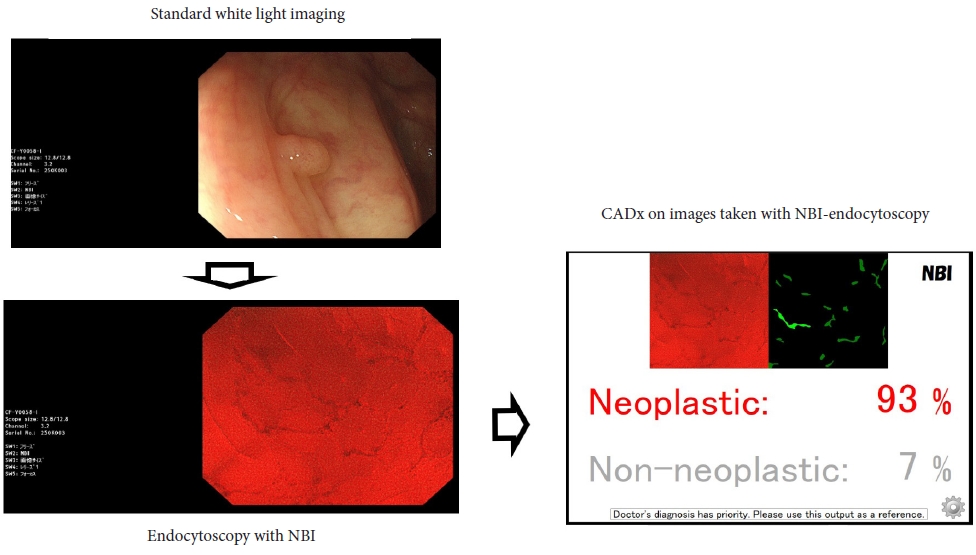
-
 Abstract
Abstract
 PDF
PDF PubReader
PubReader ePub
ePub - Computer-assisted polyp characterization (computer-aided diagnosis, CADx) facilitates optical diagnosis during colonoscopy. Several studies have demonstrated high sensitivity and specificity of CADx tools in identifying neoplastic changes in colorectal polyps. To implement CADx tools in colonoscopy, there is a need to confirm whether these tools satisfy the threshold levels that are required to introduce optical diagnosis strategies such as “diagnose-and-leave,” “resect-and-discard” or “DISCARD-lite.” In this article, we review the available data from prospective trials regarding the effect of multiple CADx tools and discuss whether they meet these thresholds.
- 2,106 View
- 159 Download

- Detecting colorectal lesions with image-enhanced endoscopy: an updated review from clinical trials
- Mizuki Nagai, Sho Suzuki, Yohei Minato, Fumiaki Ishibashi, Kentaro Mochida, Ken Ohata, Tetsuo Morishita
- Clin Endosc 2023;56(5):553-562. Published online July 26, 2023
- DOI: https://doi.org/10.5946/ce.2023.055

-
 Abstract
Abstract
 PDF
PDF PubReader
PubReader ePub
ePub - Colonoscopy plays an important role in reducing the incidence and mortality of colorectal cancer by detecting adenomas and other precancerous lesions. Image-enhanced endoscopy (IEE) increases lesion visibility by enhancing the microstructure, blood vessels, and mucosal surface color, resulting in the detection of colorectal lesions. In recent years, various IEE techniques have been used in clinical practice, each with its unique characteristics. Numerous studies have reported the effectiveness of IEE in the detection of colorectal lesions. IEEs can be divided into two broad categories according to the nature of the image: images constructed using narrowband wavelength light, such as narrowband imaging and blue laser imaging/blue light imaging, or color images based on white light, such as linked color imaging, texture and color enhancement imaging, and i-scan. Conversely, artificial intelligence (AI) systems, such as computer-aided diagnosis systems, have recently been developed to assist endoscopists in detecting colorectal lesions during colonoscopy. To better understand the features of each IEE, this review presents the effectiveness of each type of IEE and their combination with AI for colorectal lesion detection by referencing the latest research data.
-
Citations
Citations to this article as recorded by- Strategy for post-polypectomy colonoscopy surveillance: focus on the revised Korean guidelines
Yong Soo Kwon, Su Young Kim
Journal of the Korean Medical Association.2023; 66(11): 652. CrossRef - AI-powered medical devices for practical clinicians including the diagnosis of colorectal polyps
Donghwan Kim, Eunsun Kim
Journal of the Korean Medical Association.2023; 66(11): 658. CrossRef
- Strategy for post-polypectomy colonoscopy surveillance: focus on the revised Korean guidelines
- 2,442 View
- 204 Download
- 4 Web of Science
- 2 Crossref

Systematic Review and Meta-analysis
- Use of abdominal compression device in colonoscopy: a systematic review and meta-analysis
- Yousaf Zafar, Ahmed Mustafa Rashid, Syed Sarmad Javaid, Ahmed Kamal Siddiqi, Adnan Zafar, Arsalan Zafar Iqbal, Jagpal Singh Klair, Rajesh Krishnamoorthi
- Clin Endosc 2023;56(4):446-452. Published online May 26, 2023
- DOI: https://doi.org/10.5946/ce.2022.304
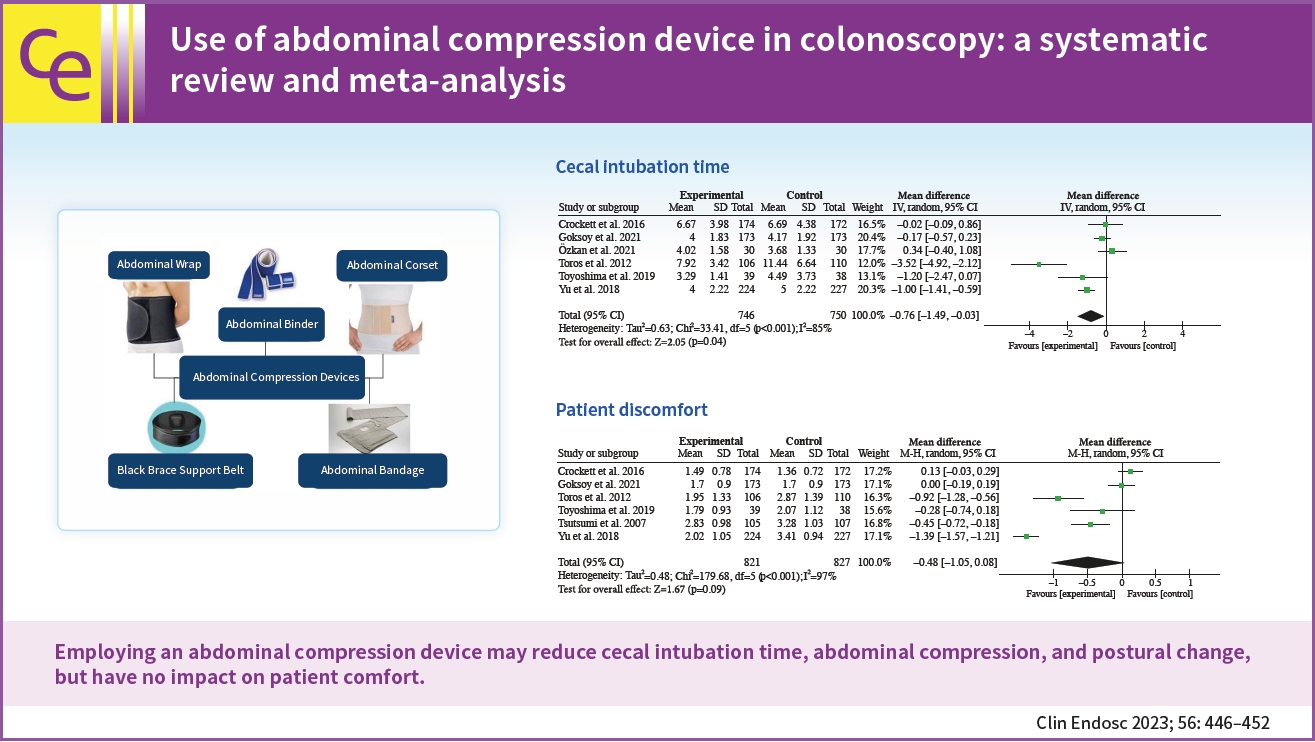
-
 Graphical Abstract
Graphical Abstract
 Abstract
Abstract
 PDF
PDF Supplementary Material
Supplementary Material PubReader
PubReader ePub
ePub 
- Background
/Aims: Colonoscopy for screening is associated with unpleasant experiences for patients, and abdominal compression devices have been developed to minimize these problems. However, there is a paucity of data supporting the therapeutic benefits of this strategy. This study examined the effects of using an abdominal compression device during colonoscopy on the cecal intubation time (CIT), abdominal compression, patient comfort, and postural changes.
Methods
We searched PubMed and Scopus (from inception to November 2021) for randomized controlled trials that assessed the effects of an abdominal compression device during colonoscopy on CIT, abdominal compression, patient comfort, and postural change. A random-effects meta-analysis was performed. Weighted mean differences (WMDs) and Mantel-Haenszel odds ratios (ORs) were calculated.
Results
Our pooled analysis of seven randomized controlled trials revealed that abdominal compression devices significantly reduced CIT (WMD, –0.76 [–1.49 to –0.03] minutes; p=0.04), abdominal compression (OR, 0.52; 95% confidence interval [CI], 0.28–0.94; p=0.03), and postural changes (OR, 0.46; 95% CI, 0.27–0.78; p=0.004) during colonoscopy. However, our results did not show a significant change in patient comfort (WMD, –0.48; 95% CI, –1.05 to 0.08; p=0.09) when using an abdominal compression device.
Conclusions
Our findings demonstrate that employing an abdominal compression device may reduce CIT, abdominal compression, and postural change but have no impact on patient comfort.
- 2,622 View
- 105 Download

Original Article
- Endoscopic versus surgical management for colonic volvulus hospitalizations in the United States
- Dushyant Singh Dahiya, Abhilash Perisetti, Hemant Goyal, Sumant Inamdar, Amandeep Singh, Rajat Garg, Chin-I Cheng, Mohammad Al-Haddad, Madhusudhan R. Sanaka, Neil Sharma
- Clin Endosc 2023;56(3):340-352. Published online April 17, 2023
- DOI: https://doi.org/10.5946/ce.2022.166
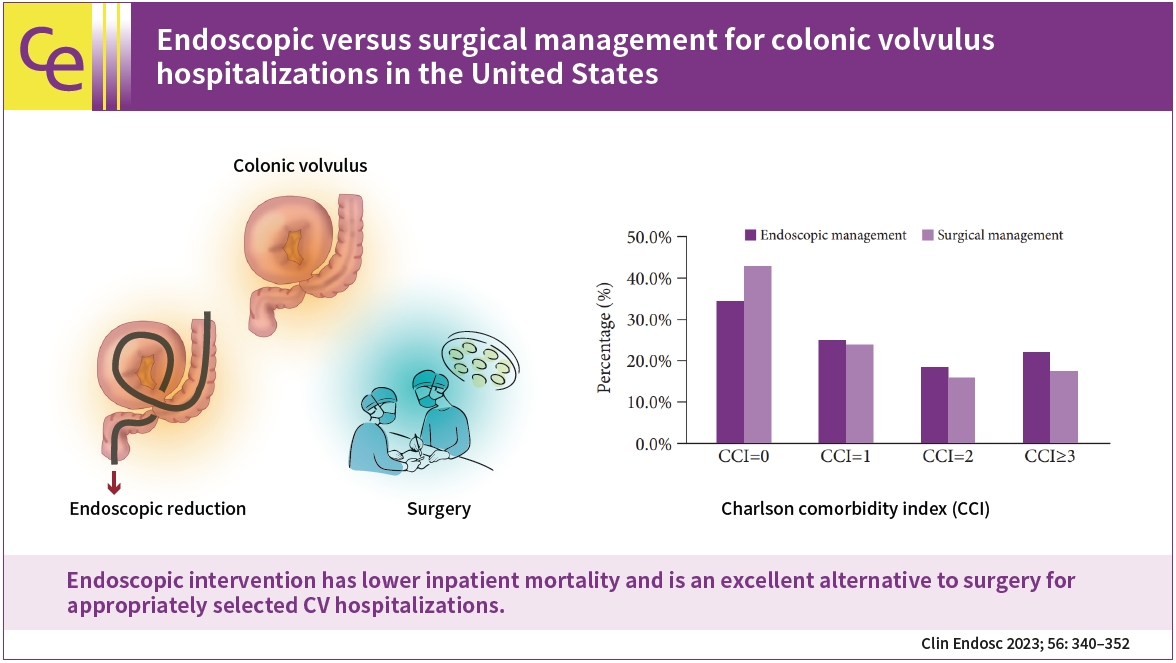
-
 Graphical Abstract
Graphical Abstract
 Abstract
Abstract
 PDF
PDF PubReader
PubReader ePub
ePub 
- Background
/Aims: Colonic volvulus (CV), a common cause of bowel obstruction, often requires intervention. We aimed to identify hospitalization trends and CV outcomes in the United States.
Methods
We used the National Inpatient Sample to identify all adult CV hospitalizations in the United States from 2007 to 2017. Patient demographics, comorbidities, and inpatient outcomes were highlighted. Outcomes of endoscopic and surgical management were compared.
Results
From 2007 to 2017, there were 220,666 CV hospitalizations. CV-related hospitalizations increased from 17,888 in 2007 to 21,715 in 2017 (p=0.001). However, inpatient mortality decreased from 7.6% in 2007 to 6.2% in 2017 (p<0.001). Of all CV-related hospitalizations, 13,745 underwent endoscopic intervention, and 77,157 underwent surgery. Although the endoscopic cohort had patients with a higher Charlson comorbidity index, we noted lower inpatient mortality (6.1% vs. 7.0%, p<0.001), mean length of stay (8.3 vs. 11.8 days, p<0.001), and mean total healthcare charge ($68,126 vs. $106,703, p<0.001) compared to the surgical cohort. Male sex, increased Charlson comorbidity index scores, acute kidney injury, and malnutrition were associated with higher odds of inpatient mortality in patients with CV who underwent endoscopic management.
Conclusions
Endoscopic intervention has lower inpatient mortality and is an excellent alternative to surgery for appropriately selected CV hospitalizations. -
Citations
Citations to this article as recorded by- Navigating Abdominal Volvulus: A Comprehensive Review of Management Strategies
Simran Chauhan, Raju K Shinde, Yashraj Jain
Cureus.2024;[Epub] CrossRef - Incidental Sigmoid Volvulus after a Ground-level Fall: An Unusual Case Report
Ziya Karimov, Elchin Shirinov, Gunay Huseynova, Mirhuseyn Mammadov, Meltem Songür Kodik
Caucasian Medical Journal.2023; 1(3): 36. CrossRef - Colonic Volvulus
Samantha L. Savitch, Calista M. Harbaugh
Clinics in Colon and Rectal Surgery.2023;[Epub] CrossRef
- Navigating Abdominal Volvulus: A Comprehensive Review of Management Strategies
- 2,157 View
- 149 Download
- 3 Web of Science
- 3 Crossref

Reviews
- Simulator-based training method in gastrointestinal endoscopy training and currently available simulators
- Yuri Kim, Jeong Hoon Lee, Gin Hyug Lee, Ga Hee Kim, Gunn Huh, Seung Wook Hong, Hwoon-Yong Jung
- Clin Endosc 2023;56(1):1-13. Published online January 6, 2023
- DOI: https://doi.org/10.5946/ce.2022.191
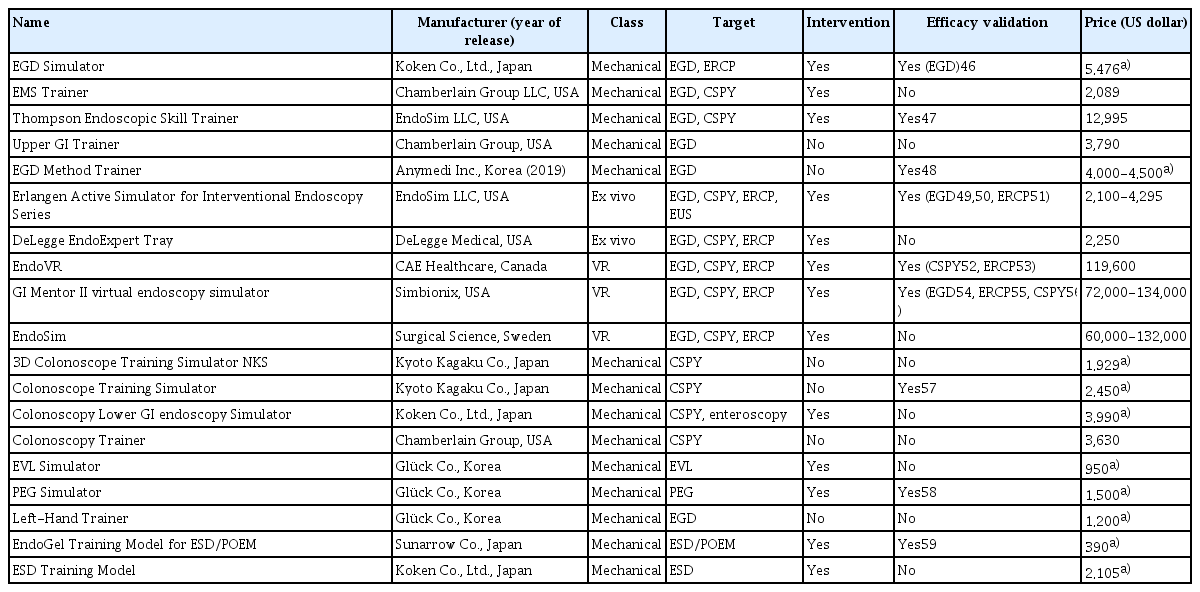
-
 Abstract
Abstract
 PDF
PDF PubReader
PubReader ePub
ePub - The apprenticeship-based training method (ABTM) is highly effective for gastrointestinal (GI) endoscopic training. However, the conventional ABTM has significant issues. Although many supplementary training methods (TMs) have been developed and utilized, they cannot entirely replace the ABTM, which remains the major TM strategy. Currently, new TM construction is crucial and necessary due to financial constraints, difficulty of obtaining sufficient training time due to patient safety-related regulations, and catastrophic damage caused by disasters such as the coronavirus disease 2019 pandemic. The simulator-based TM (SBTM) is widely accepted as an alternative to the ABTM, owing to the SBTM’s advantages. Since the 1960s, many GI endoscopy training simulators have been developed and numerous studies have been published on their effectiveness. While previous studies have focused on the simulator’s validity, this review focused on the accessibility of simulators that were introduced by the end of 2021. Although the current SBTM is effective in GI endoscopic education, extensive improvements are needed to replace the ABTM. Incorporating simulator-incorporated TMs into an improved ABTM is an attempt to overcome the incompleteness of the current SBTM. Until a new simulator is developed to replace the ABTM, it is desirable to operate a simulator-integrated and well-coordinated TM that is suitable for each country and institution.
-
Citations
Citations to this article as recorded by- Impact and assessment of training models in interventional endoscopic ultrasound
Bogdan Miutescu, Vinay Dhir
Digestive Endoscopy.2024; 36(1): 59. CrossRef - A Multicenter Survey of Percutaneous Endoscopic Gastrostomy in 2019 at Korean Medical Institutions
Jun Woo Park, Tae Gyun Kim, Kwang Bum Cho, Jeong Seok Kim, Jin Woong Cho, Jung Won Jeon, Sun Gyo Lim, Chan Gyoo Kim, Hong Jun Park, Tae Jun Kim, Eun Sun Kim, Su Jin Jeong, Yong Hwan Kwon
Gut and Liver.2024; 18(1): 77. CrossRef - Exploring Endoscopic Competence in Gastroenterology Training: A Simulation-Based Comparative Analysis of GAGES, DOPS, and ACE Assessment Tools
Faisal Wasim Ismail, Azam Afzal, Rafia Durrani, Rayyan Qureshi, Safia Awan, Michelle R Brown
Advances in Medical Education and Practice.2024; Volume 15: 75. CrossRef - Assemblage of a functional and versatile endoscopy trainer reusing medical waste: Step‐by‐step video tutorial
Riccardo Vasapolli, Jörg Schirra, Christian Schulz
Digestive Endoscopy.2024; 36(5): 634. CrossRef - Navigating the learning landscape: Comprehensive training in third space endoscopy - training, techniques, and practical recommendations
D. Roser, S. Nagl, A. Ebigbo
Best Practice & Research Clinical Gastroenterology.2024; : 101918. CrossRef - EUS and ERCP training in Europe: Time for simulation, optimization, and standardization
Selma J. Lekkerkerker, Rogier P. Voermans
United European Gastroenterology Journal.2023; 11(5): 407. CrossRef - There is no royal road: a shortcut for endoscopic submucosal dissection training
Seong Woo Jeon
Clinical Endoscopy.2023; 56(5): 590. CrossRef - Enhancing the Quality of Upper Gastrointestinal Endoscopy: Current Indicators and Future Trends
Caesar Ferrari, Micheal Tadros
Gastroenterology Insights.2023; 15(1): 1. CrossRef
- Impact and assessment of training models in interventional endoscopic ultrasound
- 2,790 View
- 215 Download
- 7 Web of Science
- 8 Crossref

- Korean guidelines for postpolypectomy colonoscopic surveillance: 2022 revised edition
- Su Young Kim, Min Seob Kwak, Soon Man Yoon, Yunho Jung, Jong Wook Kim, Sun-Jin Boo, Eun Hye Oh, Seong Ran Jeon, Seung-Joo Nam, Seon-Young Park, Soo-Kyung Park, Jaeyoung Chun, Dong Hoon Baek, Mi-Young Choi, Suyeon Park, Jeong-Sik Byeon, Hyung Kil Kim, Joo Young Cho, Moon Sung Lee, Oh Young Lee, Korean Society of Gastrointestinal Endoscopy, Korean Society of Gastroenterology, Korean Association for the Study of Intestinal Diseases
- Clin Endosc 2022;55(6):703-725. Published online October 13, 2022
- DOI: https://doi.org/10.5946/ce.2022.136
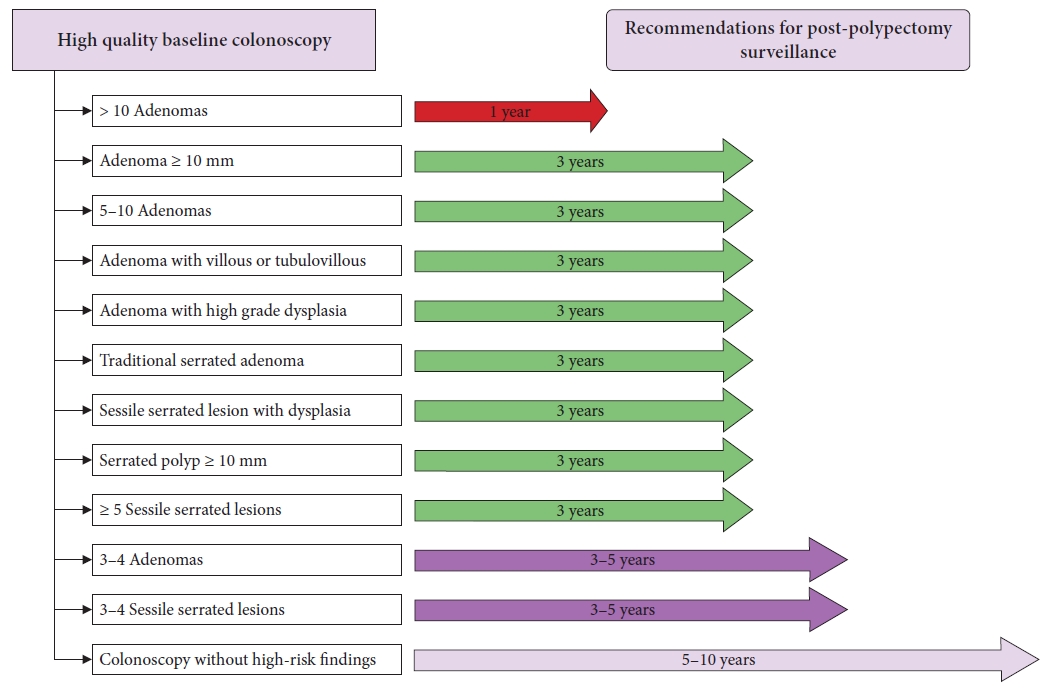
-
 Abstract
Abstract
 PDF
PDF Supplementary Material
Supplementary Material PubReader
PubReader ePub
ePub - Colonoscopic polypectomy is effective in decreasing the incidence and mortality of colorectal cancer (CRC). Premalignant polyps discovered during colonoscopy are associated with the risk of metachronous advanced neoplasia. Postpolypectomy surveillance is the most important method for the management of advanced metachronous neoplasia. A more efficient and evidence-based guideline for postpolypectomy surveillance is required because of limited medical resources and concerns regarding colonoscopy complications. In these consensus guidelines, an analytic approach was used to address all reliable evidence to interpret the predictors of CRC or advanced neoplasia during surveillance colonoscopy. The key recommendations state that the high-risk findings for metachronous CRC following polypectomy are as follows: (1) adenoma ≥10 mm in size; (2) 3 to 5 (or more) adenomas; (3) tubulovillous or villous adenoma; (4) adenoma containing high-grade dysplasia; (5) traditional serrated adenoma; (6) sessile serrated lesion (SSL) containing any grade of dysplasia; (7) serrated polyp of at least 10 mm in size; and (8) 3 to 5 (or more) SSLs. More studies are needed to fully comprehend the patients most likely to benefit from surveillance colonoscopy and the ideal surveillance interval to prevent metachronous CRC.
-
Citations
Citations to this article as recorded by- Association between Atherosclerosis and High-Risk Colorectal Adenomas based on Cardio-Ankle Vascular Index and Ankle-Brachial Index
Jung Ho Lee, Hyunseok Cho, Sang Hoon Lee, Sung Joon Lee, Chang Don Kang, Dae Hee Choi, Jin Myung Park, Seung-Joo Nam, Tae Suk Kim, Ji Hyun Kim, Sung Chul Park
The Korean Journal of Gastroenterology.2024; 83(4): 143. CrossRef - A survey of current practices in post-polypectomy surveillance in Korea
Jeongseok Kim, Tae-Geun Gweon, Min Seob Kwak, Su Young Kim, Seong Jung Kim, Hyun Gun Kim, Eun Ran Kim, Sung Noh Hong, Eun Sun Kim, Chang Mo Moon, Dae Seong Myung, Dong Hoon Baek, Shin Ju Oh, Hyun Jung Lee, Ji Young Lee, Yunho Jung, Jaeyoung Chun, Dong-Hoo
Intestinal Research.2024; 22(2): 186. CrossRef - Korean Guidelines for Postpolypectomy Colonoscopic Surveillance: 2022 Revision
Su Young Kim
The Korean Journal of Medicine.2023; 98(3): 102. CrossRef - Detecting colorectal lesions with image-enhanced endoscopy: an updated review from clinical trials
Mizuki Nagai, Sho Suzuki, Yohei Minato, Fumiaki Ishibashi, Kentaro Mochida, Ken Ohata, Tetsuo Morishita
Clinical Endoscopy.2023; 56(5): 553. CrossRef - Understanding colorectal polyps to prevent colorectal cancer
Dong-Hoon Yang
Journal of the Korean Medical Association.2023; 66(11): 626. CrossRef - Classification and endoscopic diagnosis of colorectal polyps
Ji Hyun Kim, Sung Chul Park
Journal of the Korean Medical Association.2023; 66(11): 633. CrossRef - Endoscopic treatment of colorectal polyps and early colorectal cancer
Yunho Jung
Journal of the Korean Medical Association.2023; 66(11): 642. CrossRef - Strategy for post-polypectomy colonoscopy surveillance: focus on the revised Korean guidelines
Yong Soo Kwon, Su Young Kim
Journal of the Korean Medical Association.2023; 66(11): 652. CrossRef
- Association between Atherosclerosis and High-Risk Colorectal Adenomas based on Cardio-Ankle Vascular Index and Ankle-Brachial Index
- 5,241 View
- 515 Download
- 8 Web of Science
- 8 Crossref

Original Article
- Factors influencing endoscopic estimation of colon polyp size in a colon model
- Koen Robert Beukema, Jaimy A. Simmering, Marjolein Brusse-Keizer, Sneha John, Rutger Quispel, Peter B. Mensink
- Clin Endosc 2022;55(4):540-548. Published online July 28, 2022
- DOI: https://doi.org/10.5946/ce.2022.017

-
 Abstract
Abstract
 PDF
PDF PubReader
PubReader ePub
ePub - Background
/Aims: Colorectal polyps are removed to prevent progression to colorectal cancer. Polyp size is an important factor for risk stratification of malignant transformation. Endoscopic size estimation correlates poorly with pathological reports and several factors have been suggested to influence size estimation. We aimed to gain insight into the factors influencing endoscopic polyp size estimation.
Methods
Images of polyps in an artificial model were obtained at 1, 3, and 5 cm from the colonoscope’s tip. Participants were asked to estimate the diameter and volume of each polyp.
Results
Fifteen endoscopists from three large-volume centers participated in this study. With an intraclass correlation coefficient of 0.66 (95% confidence interval [CI], 0.62–0.71) for diameter and 0.56 (95% CI, 0.50–0.62) for volume. Polyp size estimated at 3 cm from the colonoscope’s tip yielded the best results. A lower distance between the tip and the polyp was associated with a larger estimated polyp size.
Conclusions
Correct endoscopic estimation of polyp size remains challenging. This finding can affect size estimation skills and future training programs for endoscopists. -
Citations
Citations to this article as recorded by- Usefulness and Educational Benefit of a Virtual Scale Endoscope in Measuring Colorectal Polyp Size
Yudai Takehara, Ken Yamashita, Shin Morimoto, Fumiaki Tanino, Noriko Yamamoto, Yuki Kamigaichi, Hidenori Tanaka, Hidehiko Takigawa, Ryo Yuge, Yuji Urabe, Shiro Oka
Digestion.2024; 105(2): 73. CrossRef - Expert endoscopist assessment of colorectal polyp size using virtual scale endoscopy, visual or snare-based estimation: a prospective video-based study
Ioana Popescu Crainic, Roupen Djinbachian, Douglas K. Rex, Alan Barkun, Aasma Shaukat, James East, Cesare Hassan, Yuichi Mori, Heiko Pohl, Amit Rastogi, Prateek Sharma, Joseph C. Anderson, Mahsa Taghiakbari, Edgard Medawar, Daniel von Renteln
Scandinavian Journal of Gastroenterology.2024; 59(5): 608. CrossRef
- Usefulness and Educational Benefit of a Virtual Scale Endoscope in Measuring Colorectal Polyp Size
- 3,076 View
- 127 Download
- 1 Web of Science
- 2 Crossref

Review
- Post-polypectomy surveillance: the present and the future
- Masau Sekiguchi, Takahisa Matsuda, Kinichi Hotta, Yutaka Saito
- Clin Endosc 2022;55(4):489-495. Published online July 11, 2022
- DOI: https://doi.org/10.5946/ce.2022.097
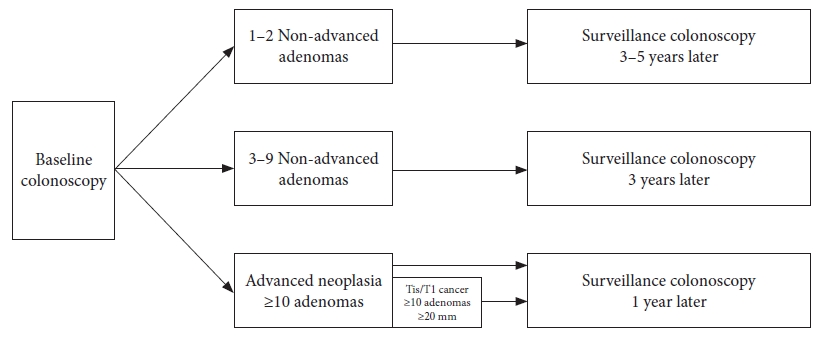
-
 Abstract
Abstract
 PDF
PDF PubReader
PubReader ePub
ePub - An appropriate post-polypectomy surveillance program requires the effectiveness of reducing colorectal cancer and safety. In addition, the post-polypectomy surveillance program should consider the burden of limited medical resource capacity, cost-effectiveness, and patient adherence. In this sense, a risk-stratified surveillance program based on baseline colonoscopy results is ideal. Major international guidelines for post-polypectomy surveillance, such as those from the European Union and the United States, have recommended risk-stratified surveillance programs. Both guidelines have recently been updated to better differentiate between high- and low-risk individuals. In both updated guidelines, more individuals have been downgraded to lower-risk groups that require less frequent or no surveillance. Furthermore, increased attention has been paid to the surveillance of patients who undergo serrated polyp removal. Previous guidelines in Japan did not clearly outline the risk stratification in post-polypectomy surveillance. However, the new colonoscopy screening and surveillance guidelines presented by the Japan Gastroenterological Endoscopy Society include a risk-stratified post-polypectomy surveillance program. Further discussion and analysis of unresolved issues in this field, such as the optimal follow-up after the first surveillance, the upper age limit for surveillance, and the ideal method for improving adherence to surveillance guidelines, are warranted.
-
Citations
Citations to this article as recorded by- Protocolo diagnóstico del seguimiento de pólipos colónicos
S. Redondo Evangelista, M. Sierra Morales, I. Bartolomé Oterino, P. García Centeno, A. Santos Rodríguez
Medicine - Programa de Formación Médica Continuada Acreditado.2024; 14(4): 219. CrossRef - Metabolic‐associated fatty liver disease is associated with colorectal adenomas in young and older Korean adults
Jiwon Chang, Yoosoo Chang, Yoosun Cho, Hyun‐Suk Jung, Dong‐Il Park, Soo‐Kyung Park, Soo‐Youn Ham, Sarah H. Wild, Christopher D. Byrne, Seungho Ryu
Liver International.2023; 43(11): 2548. CrossRef - Detecting colorectal lesions with image-enhanced endoscopy: an updated review from clinical trials
Mizuki Nagai, Sho Suzuki, Yohei Minato, Fumiaki Ishibashi, Kentaro Mochida, Ken Ohata, Tetsuo Morishita
Clinical Endoscopy.2023; 56(5): 553. CrossRef - Strategy for post-polypectomy colonoscopy surveillance: focus on the revised Korean guidelines
Yong Soo Kwon, Su Young Kim
Journal of the Korean Medical Association.2023; 66(11): 652. CrossRef - Endoscopic treatment of colorectal polyps and early colorectal cancer
Yunho Jung
Journal of the Korean Medical Association.2023; 66(11): 642. CrossRef - Understanding colorectal polyps to prevent colorectal cancer
Dong-Hoon Yang
Journal of the Korean Medical Association.2023; 66(11): 626. CrossRef
- Protocolo diagnóstico del seguimiento de pólipos colónicos
- 3,558 View
- 249 Download
- 5 Web of Science
- 6 Crossref

Original Article
-
Feasibility and safety of endoscopic submucosal dissection for lesions in proximity to a colonic diverticulum

- Nobuaki Ikezawa, Takashi Toyonaga, Shinwa Tanaka, Tetsuya Yoshizaki, Toshitatsu Takao, Hirofumi Abe, Hiroya Sakaguchi, Kazunori Tsuda, Satoshi Urakami, Tatsuya Nakai, Taku Harada, Kou Miura, Takahisa Yamasaki, Stuart Kostalas, Yoshinori Morita, Yuzo Kodama
- Clin Endosc 2022;55(3):417-425. Published online May 12, 2022
- DOI: https://doi.org/10.5946/ce.2021.245
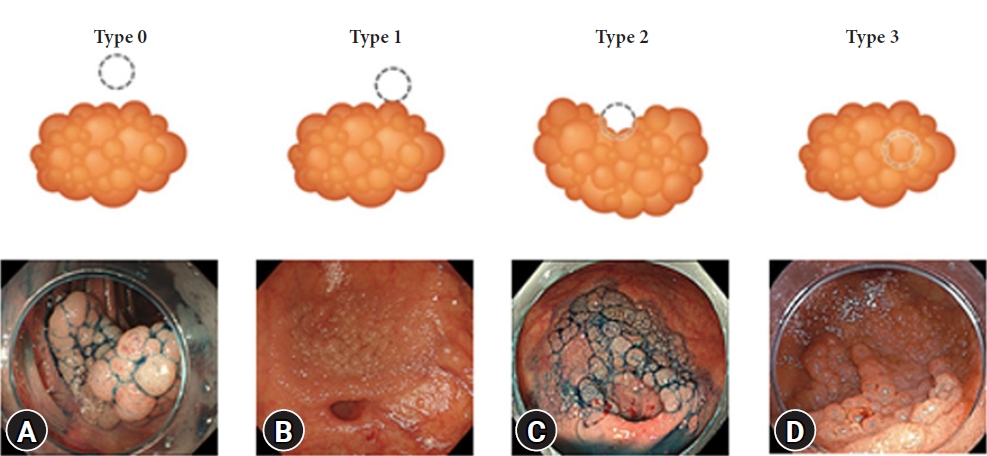
-
 Abstract
Abstract
 PDF
PDF Supplementary Material
Supplementary Material PubReader
PubReader ePub
ePub - Background
/Aims: Endoscopic submucosal dissection (ESD) for diverticulum-associated colorectal lesions is generally contraindicated because of the high risk of perforation. Several studies on patients with such lesions treated with ESD have been reported recently. However, the feasibility and safety of ESD for lesions in proximity to a colonic diverticulum (D-ESD) have not been fully clarified. The aim of this study was to evaluate the feasibility and safety of D-ESD.
Methods
D-ESD was defined as ESD for lesions within approximately 3 mm of a diverticulum. Twenty-six consecutive patients who underwent D-ESD were included. Two strategic approaches were used depending on whether submucosal dissection of the diverticulum-related part was required (strategy B) or not (strategy A). Treatment outcomes and adverse events associated with each strategy were analyzed.
Results
The en bloc resection rate was 96.2%. The rates of R0 and curative resection in strategies A and B were 80.8%, 73.1%, 84.6%, and 70.6%, respectively. Two cases of intraoperative perforation and one case of delayed perforation occurred. The delayed perforation case required emergency surgery, but the other cases were managed conservatively.
Conclusions
D-ESD may be a feasible treatment option. However, it should be performed in a high-volume center by expert hands because it requires highly skilled endoscopic techniques. -
Citations
Citations to this article as recorded by- Endoscopic submucosal dissection for diverticulum using combination of countertraction and circumferential-inversion method
Hiroshi Takayama, Yoshinori Morita, Toshitatsu Takao, Douglas Motomura, Madoka Takao, Takashi Toyonaga, Yuzo Kodama
Endoscopy.2024; 56(S 01): E91. CrossRef - Traction-assisted endoscopic submucosal dissection for resection of ileocecal valve neoplasia: a French retrospective multicenter case series
Clara Yzet, Timothée Wallenhorst, Jérémie Jacques, Mariana Figueiredo Ferreira, Jérôme Rivory, Florian Rostain, Louis-Jean Masgnaux, Jean Grimaldi, Romain Legros, Pierre Lafeuille, Jérémie Albouys, Fabien Subtil, Marion Schaefer, Mathieu Pioche
Endoscopy.2024;[Epub] CrossRef - The role of cap-assisted endoscopy and its future implications
Sol Kim, Bo-In Lee
Clinical Endoscopy.2024; 57(3): 293. CrossRef - Successful planned piecemeal endoscopic resection using gel immersion and an over-the-scope clip for a lesion extensively extended into the colonic diverticulum
Tomoaki Tashima, Takahiro Muramatsu, Tomonori Kawasaki, Tsubasa Ishikawa, Shomei Ryozawa
VideoGIE.2023; 8(4): 167. CrossRef - Future therapeutic implications of new molecular mechanism of colorectal cancer
Sen Lu, Cheng-You Jia, Jian-She Yang
World Journal of Gastroenterology.2023; 29(16): 2359. CrossRef - Iatrogenic colorectal perforation caused by a clip
Hirotaka Oura, Yasuki Hatayama, Erika Nomura, Harutoshi Sugiyama, Daisuke Murakami, Makoto Arai, Takayoshi Nishino
Endoscopy.2023; 55(S 01): E1091. CrossRef
- Endoscopic submucosal dissection for diverticulum using combination of countertraction and circumferential-inversion method
- 3,726 View
- 171 Download
- 4 Web of Science
- 6 Crossref

Systematic Review and Meta-Analysis
- Does computer-aided diagnostic endoscopy improve the detection of commonly missed polyps? A meta-analysis
- Arun Sivananthan, Scarlet Nazarian, Lakshmana Ayaru, Kinesh Patel, Hutan Ashrafian, Ara Darzi, Nisha Patel
- Clin Endosc 2022;55(3):355-364. Published online May 12, 2022
- DOI: https://doi.org/10.5946/ce.2021.228
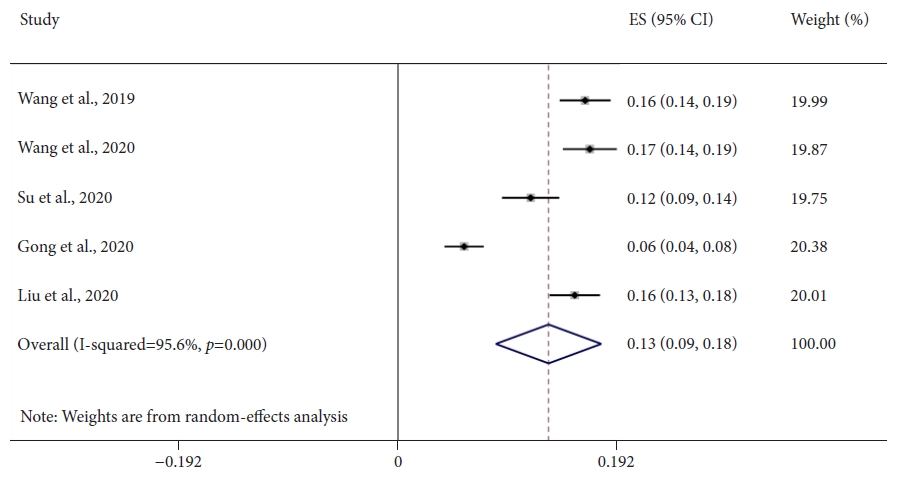
-
 Abstract
Abstract
 PDF
PDF PubReader
PubReader ePub
ePub - Background
/Aims: Colonoscopy is the gold standard diagnostic method for colorectal neoplasia, allowing detection and resection of adenomatous polyps; however, significant proportions of adenomas are missed. Computer-aided detection (CADe) systems in endoscopy are currently available to help identify lesions. Diminutive (≤5 mm) and nonpedunculated polyps are most commonly missed. This meta-analysis aimed to assess whether CADe systems can improve the real-time detection of these commonly missed lesions.
Methods
A comprehensive literature search was performed. Randomized controlled trials evaluating CADe systems categorized by morphology and lesion size were included. The mean number of polyps and adenomas per patient was derived. Independent proportions and their differences were calculated using DerSimonian and Laird random-effects modeling.
Results
Seven studies, including 2,595 CADe-assisted colonoscopies and 2,622 conventional colonoscopies, were analyzed. CADe-assisted colonoscopy demonstrated an 80% increase in the mean number of diminutive adenomas detected per patient compared with conventional colonoscopy (0.31 vs. 0.17; effect size, 0.13; 95% confidence interval [CI], 0.09–0.18); it also demonstrated a 91.7% increase in the mean number of nonpedunculated adenomas detected per patient (0.32 vs. 0.19; effect size, 0.05; 95% CI, 0.02–0.07).
Conclusions
CADe-assisted endoscopy significantly improved the detection of most commonly missed adenomas. Although this method is a potentially exciting technology, limitations still apply to current data, prompting the need for further real-time studies. -
Citations
Citations to this article as recorded by- Use of artificial intelligence in the management of T1 colorectal cancer: a new tool in the arsenal or is deep learning out of its depth?
James Weiquan Li, Lai Mun Wang, Katsuro Ichimasa, Kenneth Weicong Lin, James Chi-Yong Ngu, Tiing Leong Ang
Clinical Endoscopy.2024; 57(1): 24. CrossRef - As how artificial intelligence is revolutionizing endoscopy
Jean-Francois Rey
Clinical Endoscopy.2024; 57(3): 302. CrossRef - Eye tracking technology in endoscopy: Looking to the future
Arun Sivananthan, Jabed Ahmed, Alexandros Kogkas, George Mylonas, Ara Darzi, Nisha Patel
Digestive Endoscopy.2023; 35(3): 314. CrossRef - Artificial intelligence and the push for small adenomas: all we need?
Katharina Zimmermann-Fraedrich, Thomas Rösch
Endoscopy.2023; 55(04): 320. CrossRef - Recent advances in devices and technologies that might prove revolutionary for colonoscopy procedures
Jonathan S. Galati, Kevin Lin, Seth A. Gross
Expert Review of Medical Devices.2023; 20(12): 1087. CrossRef - Detecting colorectal lesions with image-enhanced endoscopy: an updated review from clinical trials
Mizuki Nagai, Sho Suzuki, Yohei Minato, Fumiaki Ishibashi, Kentaro Mochida, Ken Ohata, Tetsuo Morishita
Clinical Endoscopy.2023; 56(5): 553. CrossRef - KI-Werkzeuge als smarte Helfer in Klinik und Forschung
Zeitschrift für Gastroenterologie.2023; 61(11): 1544. CrossRef - AI-powered medical devices for practical clinicians including the diagnosis of colorectal polyps
Donghwan Kim, Eunsun Kim
Journal of the Korean Medical Association.2023; 66(11): 658. CrossRef - The Role of Artificial Intelligence in Colorectal Cancer Screening: Lesion Detection and Lesion Characterization
Edward Young, Louisa Edwards, Rajvinder Singh
Cancers.2023; 15(21): 5126. CrossRef - Artificial intelligence for colorectal neoplasia detection during colonoscopy: a systematic review and meta-analysis of randomized clinical trials
Shenghan Lou, Fenqi Du, Wenjie Song, Yixiu Xia, Xinyu Yue, Da Yang, Binbin Cui, Yanlong Liu, Peng Han
eClinicalMedicine.2023; 66: 102341. CrossRef - Pouring some water into the wine—Poor performance of endoscopists in artificial intelligence studies
Jochen Weigt
United European Gastroenterology Journal.2022; 10(8): 793. CrossRef
- Use of artificial intelligence in the management of T1 colorectal cancer: a new tool in the arsenal or is deep learning out of its depth?
- 3,034 View
- 155 Download
- 11 Web of Science
- 11 Crossref

Reviews
- Quality indicators in colonoscopy: the chasm between ideal and reality
- Su Bee Park, Jae Myung Cha
- Clin Endosc 2022;55(3):332-338. Published online April 4, 2022
- DOI: https://doi.org/10.5946/ce.2022.037
-
 Abstract
Abstract
 PDF
PDF PubReader
PubReader ePub
ePub - Continuous measurement of quality indicators (QIs) should be a routine part of colonoscopy, as a wide variation still exists in the performance and quality levels of colonoscopy in Korea. Among the many QIs of colonoscopy, the adenoma detection rate, average withdrawal time, bowel preparation adequacy, and cecal intubation rate should be monitored in daily clinical practice to improve the quality of the procedure. The adenoma detection rate is the best indicator of the quality of colonoscopy; however, it has many limitations for universal use in daily practice. With the development of natural language processing, the adenoma detection rate is expected to become more effective and useful. It is important that colonoscopists do not strictly and mechanically maintain an average withdrawal time of 6 minutes but instead perform careful colonoscopy to maximally expose the colonic mucosa with a withdrawal time of at least 6 minutes. To achieve adequate bowel preparation, documentation of bowel preparation with the Boston Bowel Preparation Scale (BBPS) should be a routine part of colonoscopy. When colonoscopists routinely followed the bowel preparation protocols, ≥85% of outpatient screening colonoscopies had a BBPS score of ≥6. In addition, the cecal intubation rate should be ≥95% of all screening colonoscopies. The first step in improving colonoscopy quality in Korea is to apply these key performance measurements in clinical practice.
-
Citations
Citations to this article as recorded by- What are the priority quality indicators for colonoscopy in real‐world clinical practice?
Kasenee Tiankanon, Satimai Aniwan
Digestive Endoscopy.2024; 36(1): 30. CrossRef - A Systematic Review of Exercise Therapy for Bowel Preparation
Yuan-Yuan Zhang, Ramoo Vimala, Ping Lei Chui, Ida Normiha Hilmi
Gastroenterology Nursing.2023; 46(5): 393. CrossRef - Detecting colorectal lesions with image-enhanced endoscopy: an updated review from clinical trials
Mizuki Nagai, Sho Suzuki, Yohei Minato, Fumiaki Ishibashi, Kentaro Mochida, Ken Ohata, Tetsuo Morishita
Clinical Endoscopy.2023; 56(5): 553. CrossRef - AI-powered medical devices for practical clinicians including the diagnosis of colorectal polyps
Donghwan Kim, Eunsun Kim
Journal of the Korean Medical Association.2023; 66(11): 658. CrossRef
- What are the priority quality indicators for colonoscopy in real‐world clinical practice?
- 3,125 View
- 219 Download
- 5 Web of Science
- 4 Crossref

- Can Computed Tomography Colonography Replace Optical Colonoscopy in Detecting Colorectal Lesions?: State of the Art
- Alessia Chini, Michele Manigrasso, Grazia Cantore, Rosa Maione, Marco Milone, Francesco Maione, Giovanni Domenico De Palma
- Clin Endosc 2022;55(2):183-190. Published online February 24, 2022
- DOI: https://doi.org/10.5946/ce.2021.254
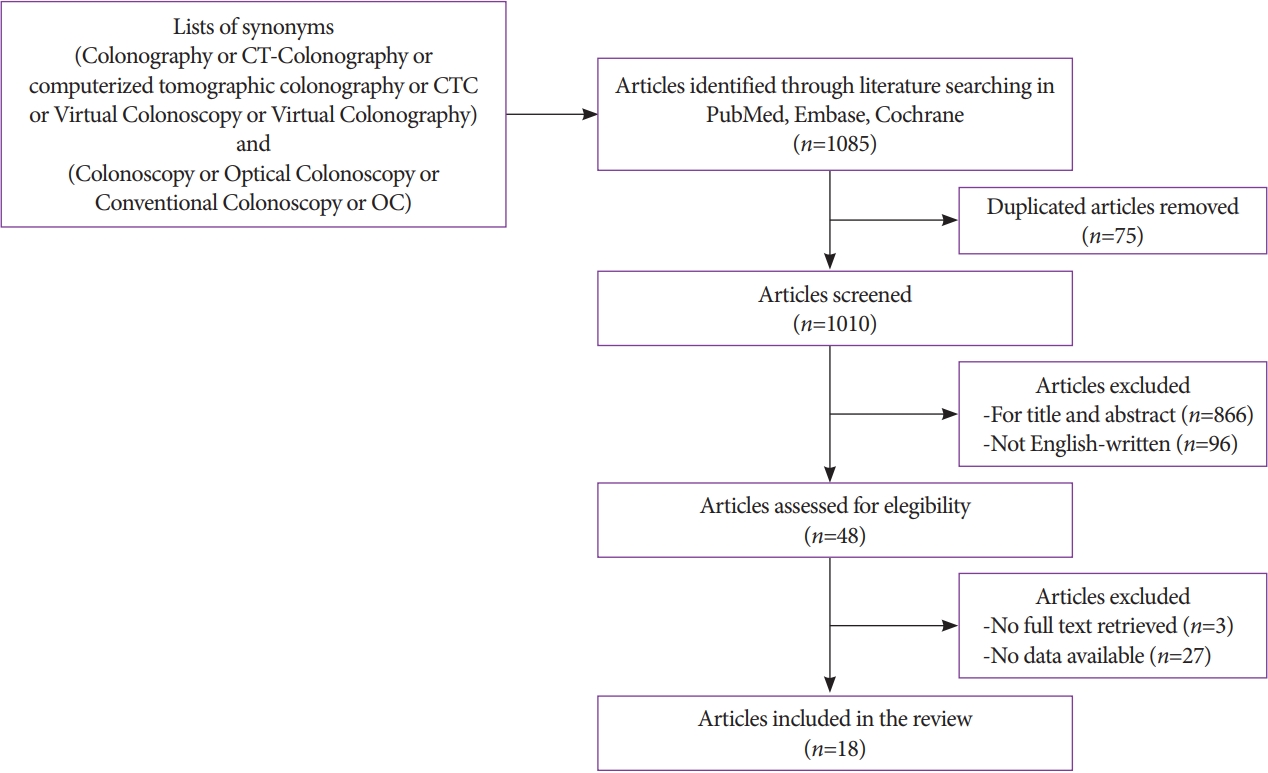
-
 Abstract
Abstract
 PDF
PDF PubReader
PubReader ePub
ePub - Colorectal cancer is an important cause of morbidity and mortality worldwide. Optical colonoscopy (OC) is widely accepted as the reference standard for the screening of colorectal polyps and cancers, and computed tomography colonography (CTC) is a valid alternative to OC. The purpose of this review was to assess the diagnostic accuracy of OC and CTC for colorectal lesions. A literature search was performed in PubMed, Embase, and Cochrane Library, and 18 articles were included. CTC has emerged in recent years as a potential screening examination with high accuracy for the detection of colorectal lesions. However, the clinical application of CTC as a screening technique is limited because it is highly dependent on the size of the lesions and has poor performance in detecting individual lesions <5 mm or flat lesions, which, although rarely, can have a malignant potential.
-
Citations
Citations to this article as recorded by- Multi-view orientational attention network combining point-based affinity for polyp segmentation
Yan Liu, Yan Yang, Yongquan Jiang, Zhuyang Xie
Expert Systems with Applications.2024; 249: 123663. CrossRef - The Influence of Mechanical Bowel Preparation on Volatile Organic Compounds for the Detection of Gastrointestinal Disease—A Systematic Review
Ashwin Krishnamoorthy, Subashini Chandrapalan, Sofie Bosch, Ayman Bannaga, Nanne K.H. De Boer, Tim G.J. De Meij, Marcis Leja, George B. Hanna, Nicoletta De Vietro, Donato Altomare, Ramesh P. Arasaradnam
Sensors.2023; 23(3): 1377. CrossRef - The Detection of Colorectal Cancer through Machine Learning-Based Breath Sensor Analysis
Inese Poļaka, Linda Mežmale, Linda Anarkulova, Elīna Kononova, Ilona Vilkoite, Viktors Veliks, Anna Marija Ļeščinska, Ilmārs Stonāns, Andrejs Pčolkins, Ivars Tolmanis, Gidi Shani, Hossam Haick, Jan Mitrovics, Johannes Glöckler, Boris Mizaikoff, Mārcis Lej
Diagnostics.2023; 13(21): 3355. CrossRef
- Multi-view orientational attention network combining point-based affinity for polyp segmentation
- 3,801 View
- 233 Download
- 4 Web of Science
- 3 Crossref

Original Article
- Comparison of conventional and new endoscopic band ligation devices for colonic diverticular bleeding
- Ayaka Takasu, Takashi Ikeya, Yasutoshi Shiratori
- Clin Endosc 2022;55(3):408-416. Published online February 18, 2022
- DOI: https://doi.org/10.5946/ce.2021.200

-
 Abstract
Abstract
 PDF
PDF PubReader
PubReader ePub
ePub - Background
/Aims: Endoscopic band ligation (EBL) is used to treat colonic diverticular bleeding (CDB). An endoscopic variceal ligation device for esophageal varices is used as a conventional EBL device (C-EBL). A new EBL device (N-EBL) was developed by Sumitomo Bakelite Co. in August 2018. We aimed to evaluate the clinical outcomes of N-EBL compared with those of C-EBL.
Methods
Seventy-nine patients who underwent EBL for CDB at St. Luke’s International Hospital, Japan, between 2017 and 2020 were included in this retrospective study. Patients were divided into the C-EBL and N-EBL groups. Their clinical outcomes, including achieving initial hemostasis, early rebleeding, procedure time, and EBL-associated adverse events, were evaluated.
Results
Of the 79 patients, 36 (45.6%) were in the C-EBL group and 43 (54.4%) were in the N-EBL group. The rate of achieving initial hemostasis was 100% in the C-EBL group and 93.0% in the N-EBL group. No significant difference was noted in the early rebleeding rate between the groups (p=0.24). The N-EBL group achieved a shorter median EBL procedure time than the C-EBL group (18.2 minutes vs. 14.2 minutes, p=0.02). No adverse events were observed in either group.
Conclusions
The N-EBL device is safe and useful and may reduce EBL procedure time. -
Citations
Citations to this article as recorded by- Advances in endoscopic management of colonic diverticular bleeding
Yasutoshi Shiratori, Syed Matthew Kodilinye, Ahmed E. Salem
Current Opinion in Gastroenterology.2024;[Epub] CrossRef - Management of Patients With Acute Lower Gastrointestinal Bleeding: An Updated ACG Guideline
Neil Sengupta, Joseph D. Feuerstein, Vipul Jairath, Amandeep K. Shergill, Lisa L. Strate, Robert J. Wong, David Wan
American Journal of Gastroenterology.2023; 118(2): 208. CrossRef - Effective endoscopic band ligation for diverticular perforation with a refractory pelvic abscess
Koichi Soga, Atsushi Majima
Clinical Endoscopy.2023; 56(2): 252. CrossRef - A new band ligation device to treat colonic diverticular bleeding
Yunho Jung
Clinical Endoscopy.2022; 55(3): 367. CrossRef
- Advances in endoscopic management of colonic diverticular bleeding
- 3,846 View
- 237 Download
- 2 Web of Science
- 4 Crossref

Special Article: Celebrating the 10th Anniversary of Clinical Endoscopy
- Document Network and Conceptual and Social Structures of Clinical Endoscopy from 2015 to July 2021 Based on the Web of Science Core Collection: A Bibliometric Study
- Sun Huh
- Clin Endosc 2021;54(5):641-650. Published online September 30, 2021
- DOI: https://doi.org/10.5946/ce.2021.207
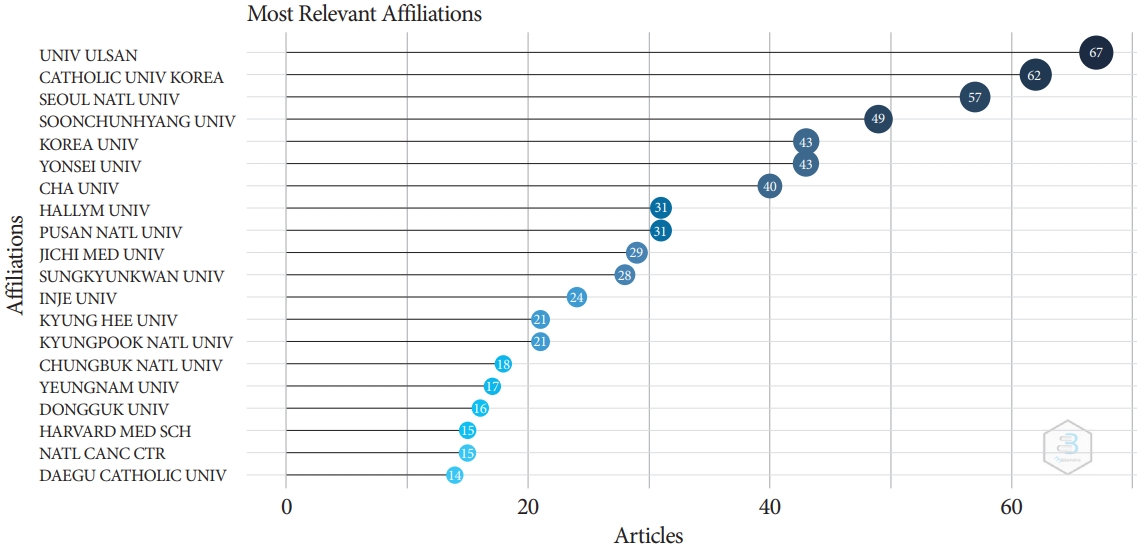
-
 Abstract
Abstract
 PDF
PDF Supplementary Material
Supplementary Material PubReader
PubReader ePub
ePub - Background
/Aims: The present study investigated the relevance and network of institutions, keywords, and authors’ countries of the articles in Clinical Endoscopy published from 2015 to May 2021 based on the Web of Science Core Collection.
Methods
The Web of Science Core Collection was searched with the term Clinical Endoscopy as the publication title on July 12, 2021. All 776 citations published from 2015 to May 2021 and 2,964 articles citing those 776 articles were analyzed using Biblioshiny.
Results
The corresponding authors were from 73 countries. Document coupling showed that the colorectal cancer-colonoscopyrandomized controlled trial cluster had the most significant impact and highest centrality. There were 442 articles with corresponding authors from Korea (57.0%). The number of collaborative works by Korean authors with the authors of other countries was 33 (7.5%). The articles were cited 2,964 times by corresponding authors from 37 countries.
Conclusions
The above results show that Clinical Endoscopy has published several studies on gastrointestinal endoscopy. A large proportion of citations (84.7 %) were from outside Korea, indicating that the journal content is useful for global physicians. Collaborative work between authors from Korea and other countries should be encouraged to promote the journal. -
Citations
Citations to this article as recorded by- Research Progress in Land Consolidation and Rural Revitalization: Current Status, Characteristics, Regional Differences, and Evolution Laws
Shuchang Li, Wei Song
Land.2023; 12(1): 210. CrossRef - Journal metrics, document network, and conceptual and social structures of the Korean Journal of Anesthesiology from 2017 to July 2022: a bibliometric study
Sun Huh
Korean Journal of Anesthesiology.2023; 76(1): 3. CrossRef - Promotion to Top-Tier Journal and Development Strategy of the Annals of Laboratory Medicine for Strengthening its Leadership in the Medical Laboratory Technology Category: A Bibliometric Study
Sun Huh
Annals of Laboratory Medicine.2022; 42(3): 321. CrossRef - Research trends on endoscopic mucosal resection: A bibliometric analysis from 1991 to 2021
Yihan Yang, Xuan Xu, Menghui Wang, Yang Zhang, Pinglang Zhou, Sifan Yang, Xu Shu, Chuan Xie
Frontiers in Surgery.2022;[Epub] CrossRef - Riesgo de sangrado gastrointestinal por uso de anticoagulantes directos orales: ¿cuál es más seguro?
Ivan David Lozada Martinez, Luis Carlos Solano Díaz, Marcela Barbosa Pérez, Víctor Andrés Rueda Oviedo, Brainerd Lenin Caicedo Moncada, Gustavo Andrés Diaz Cruz, Adriana cristina Ceballos Espitia, David Esteban Diaz Gómez, Daiana Andrea Rojas Ramí
Revista Cuarzo.2022; 28(2): 31. CrossRef
- Research Progress in Land Consolidation and Rural Revitalization: Current Status, Characteristics, Regional Differences, and Evolution Laws
- 3,433 View
- 61 Download
- 4 Web of Science
- 5 Crossref

Original Article
- Colorectal Cancer Screening with Computed Tomography Colonography: Single Region Experience in Kazakhstan
- Jandos Amankulov, Dilyara Kaidarova, Zhamilya Zholdybay, Marianna Zagurovskaya, Nurlan Baltabekov, Madina Gabdullina, Akmaral Ainakulova, Dias Toleshbayev, Alexandra Panina, Elvira Satbayeva, Zhansaya Kalieva
- Clin Endosc 2022;55(1):101-112. Published online July 15, 2021
- DOI: https://doi.org/10.5946/ce.2021.066
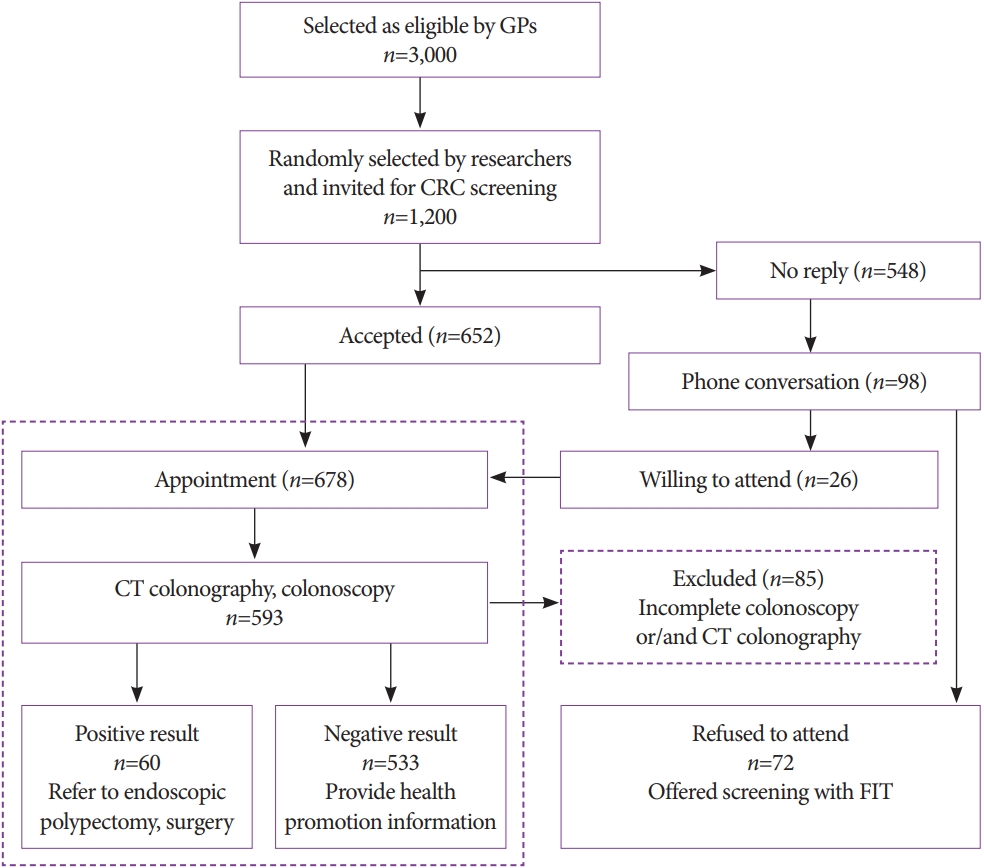
-
 Abstract
Abstract
 PDF
PDF PubReader
PubReader ePub
ePub - Background
/Aims: The aim of our study was to determine the efficacy of computed tomography colonography (CTC) in screening for colorectal cancer (CRC).
Methods
A total of 612 females and 588 males aged 45 to 75 years were enrolled in CTC screening. CTC was performed following standard bowel preparation and colonic insufflation with carbon dioxide. The main outcomes were the detection rate of CRC and advanced adenoma (AA), prevalence of colorectal lesions in relation to socio-demographic and health factors, and overall diagnostic performance of CTC.
Results
Overall, 56.5% of the 1,200 invited subjects underwent CTC screening. The sensitivity for CRC and AA was 0.89 and 0.97, respectively, while the specificity was 0.71 and 0.99, respectively. The prevalence of CRC and AA was 3.0% (18/593) and 7.1% (42/593), respectively, with the highest CRC prevalence in the 66-75 age group (≥12 times; odds ratio [OR], 12.11; 95% confidence interval [CI], 4.45-32.92). CRC and AA prevalence were inversely correlated with Asian descent, physical activity, and negative fecal immunochemical test results (OR=0.43; 95% CI, 0.22-0.83; OR=0.16; 95% CI, 0.04-0.68; OR=0.5; 95% CI, 0.07-3.85, respectively).
Conclusions
Our study revealed high accuracy of CTC in diagnosing colonic neoplasms, good compliance with CTC screening, and high detection rate of CRC.
- 5,703 View
- 205 Download
- 1 Web of Science

Focused Review Series: Image-Enhanced Endoscopy: Update on Clinical Practice
- Clinical Applications of Linked Color Imaging and Blue Laser/Light Imaging in the Screening, Diagnosis, and Treatment of Superficial Colorectal Tumors
- Taku Sakamoto, Hourin Cho, Yutaka Saito
- Clin Endosc 2021;54(4):488-493. Published online July 14, 2021
- DOI: https://doi.org/10.5946/ce.2021.157
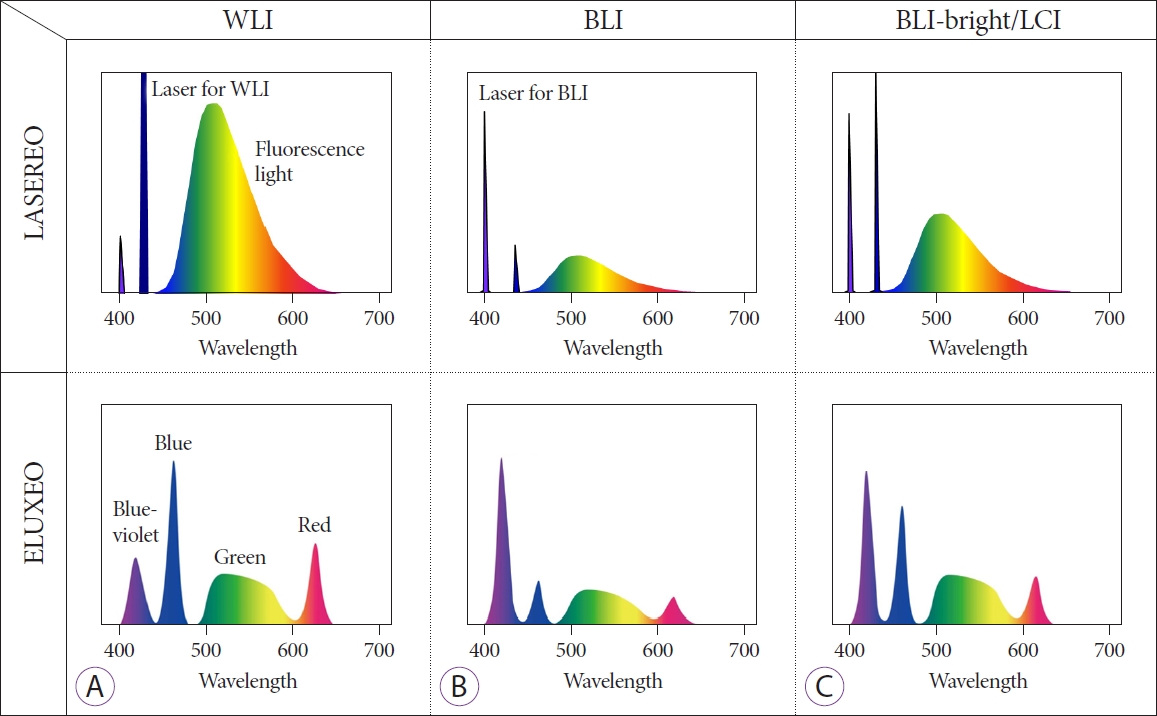
-
 Abstract
Abstract
 PDF
PDF PubReader
PubReader ePub
ePub - Considering its contribution to reducing colorectal cancer morbidity and mortality, the most important task of colonoscopy is to find all existing polyps. Moreover, the accurate detection of existing polyps determines the risk of colorectal cancer morbidity and is an important factor in deciding the appropriate surveillance program for patients. Image-enhanced endoscopy is an easy-to-use modality with improved lesion detection. Linked color imaging (LCI) and blue laser/light imaging (BLI) are useful modalities for improving colonoscopy quality. Each mode has unique optical features; therefore, their intended use differs. LCI contributes to improved polyp detection due to its brightness and high color contrast between the lesion and normal mucosa, while BLI contributes to the characterization of detected polyps by evaluating the vessel and surface patterns of detected lesions. The proper use of these observation modes allows for more efficient endoscopic diagnosis. Moreover, recent developments in artificial intelligence will soon change the clinical practice of colonoscopy and this system will provide an efficient education modality for novice endoscopists.
-
Citations
Citations to this article as recorded by- Endoscopic features with associated histological and molecular alterations in serrated polyps with dysplasia: Retrospective analysis of a tertiary case series
Antonello Trecca, Raffaele Borghini, Daniela Medicina, Rachele Del Sordo, Giulio Mandelli, Antonino Bella, Giuseppe Galloro, Kuang-I Fu, Vincenzo Villanacci
Digestive and Liver Disease.2024; 56(4): 687. CrossRef - Linked-color imaging with or without artificial intelligence for adenoma detection: a randomized trial
Kazuya Miyaguchi, Yoshikazu Tsuzuki, Nobutaka Hirooka, Hisashi Matsumoto, Hideki Ohgo, Hidetomo Nakamoto, Hiroyuki Imaeda
Endoscopy.2024; 56(05): 376. CrossRef - The Diagnostic Performance of Linked Color Imaging Compared to White Light Imaging in Endoscopic Diagnosis of Helicobacter pylori Infection: A Systematic Review and Meta-Analysis
Jae Gon Lee, In Kyung Yoo, Abdullah Ozgur Yeniova, Sang Pyo Lee
Gut and Liver.2024; 18(3): 444. CrossRef - Linked color imaging improves the diagnostic accuracy of eosinophilic esophagitis
Yasuhiko Abe, Yu Sasaki, Makoto Yagi, Naoko Mizumoto, Yusuke Onozato, Takashi Kon, Masakuni Shoji, Kazuhiro Sakuta, Takayuki Sakai, Matsuki Umehara, Minami Ito, Shuhei Nakamura, Hidemoto Tsuchida, Yoshiyuki Ueno
DEN Open.2023;[Epub] CrossRef - Comparison of LED and LASER Colonoscopy About Linked Color Imaging and Blue Laser/Light Imaging of Colorectal Tumors in a Multinational Study
Naohisa Yoshida, Peter V. Draganov, Sneha John, Helmut Neumann, Rafiz Abdul Rani, Wen-Hsin Hsu, Nilesh Fernandopulle, Kewin Tien Ho Siah, Ricardo Morgenstern, Yuri Tomita, Ken Inoue, Osamu Dohi, Ryohei Hirose, Yoshito Itoh, Takaaki Murakami, Yoshikazu Ina
Digestive Diseases and Sciences.2023; 68(10): 3943. CrossRef - Classification and endoscopic diagnosis of colorectal polyps
Ji Hyun Kim, Sung Chul Park
Journal of the Korean Medical Association.2023; 66(11): 633. CrossRef - Role of linked color imaging for upper gastrointestinal disease: present and future
Sang Pyo Lee
Clinical Endoscopy.2023; 56(5): 546. CrossRef - Detecting colorectal lesions with image-enhanced endoscopy: an updated review from clinical trials
Mizuki Nagai, Sho Suzuki, Yohei Minato, Fumiaki Ishibashi, Kentaro Mochida, Ken Ohata, Tetsuo Morishita
Clinical Endoscopy.2023; 56(5): 553. CrossRef - Images of laser and light‐emitting diode colonoscopy for comparing large colorectal lesion visibility with linked color imaging and white‐light imaging
Naohisa Yoshida, Yoshikazu Hayashi, Hiroshi Kashida, Yuri Tomita, Osamu Dohi, Ken Inoue, Ryohei Hirose, Yoshito Itoh, Masahiro Okada, Shiori Yoshimoto, Toshihiro Fujinuma, Hirotsugu Sakamoto, Keijiro Sunada, Yoriaki Komeda, Ikue Sekai, Natsuki Okai, Hiron
Digestive Endoscopy.2022; 34(7): 1413. CrossRef
- Endoscopic features with associated histological and molecular alterations in serrated polyps with dysplasia: Retrospective analysis of a tertiary case series
- 3,979 View
- 147 Download
- 9 Web of Science
- 9 Crossref

Case Reports
- Extracutaneous mastocytoma of colon: a case report and literature review
- Min Su Chu, Eui Joong Kim
- Clin Endosc 2022;55(6):810-814. Published online July 7, 2021
- DOI: https://doi.org/10.5946/ce.2021.003
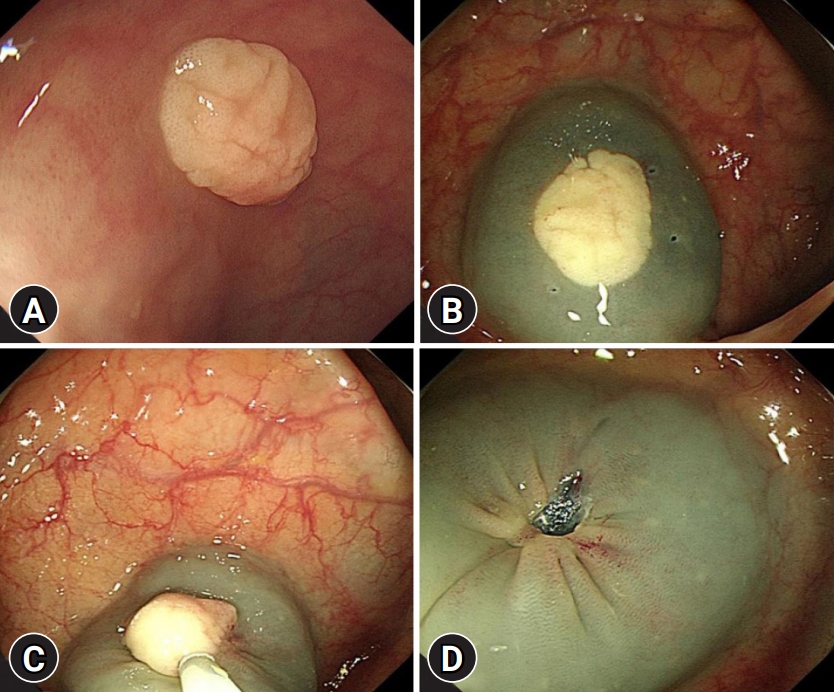
-
 Abstract
Abstract
 PDF
PDF PubReader
PubReader ePub
ePub - Extracutaneous mastocytoma is a rare benign tumor composed of mature mast cells and is located in tissues other than the skin. We report the case of a 61-year-old male who was diagnosed with extracutaneous mastocytoma via colonoscopic polypectomy and biopsy. To our knowledge, this was the first case of a solitary extracutaneous mastocytoma of the colon. We reported this case and reviewed the literature.
-
Citations
Citations to this article as recorded by- Incidental discovery of KIT‐mutated mastocytoma in a colon polyp
Naseema Gangat, Ellen McPhail, Kaaren Reichard, Attilio Orazi, Animesh Pardanani, Ayalew Tefferi
American Journal of Hematology.2024; 99(5): 973. CrossRef
- Incidental discovery of KIT‐mutated mastocytoma in a colon polyp
- 3,362 View
- 161 Download
- 1 Web of Science
- 1 Crossref

- Endoscopic Treatment of Iatrogenic Perforation of Sigmoid Diverticulum: A Case Report of Multidisciplinary Management
- Giacomo Emanuele Maria Rizzo, Giuseppina Ferro, Giovanna Rizzo, Giovanni Di Carlo, Alessandro Cantone, Gaetano Giuseppe Di Vita, Carmelo Sciumè
- Clin Endosc 2022;55(2):292-296. Published online June 7, 2021
- DOI: https://doi.org/10.5946/ce.2021.005
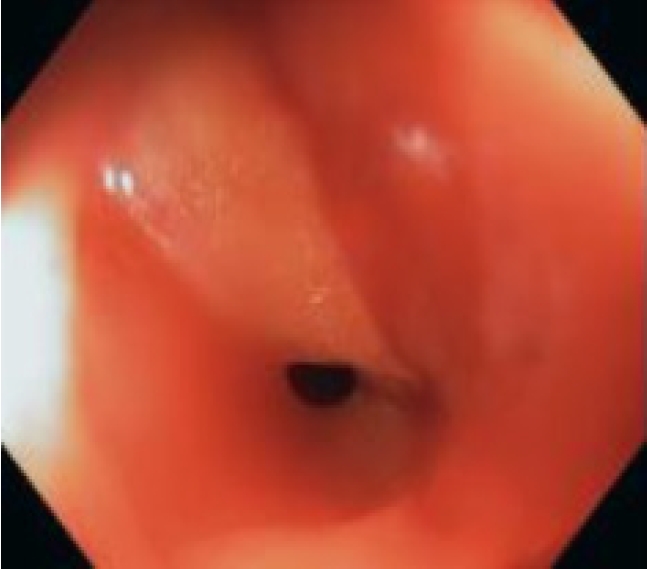
-
 Abstract
Abstract
 PDF
PDF PubReader
PubReader ePub
ePub - Iatrogenic perforations are severe complications of gastrointestinal endoscopy; therefore, their management should be adequately planned. A 77-year-old man with a history of diverticulosis underwent a colonoscopy for anemia. During the procedure, an iatrogenic perforation occurred suddenly in the sigmoid colon, near a severe angle among the numerous diverticula. Through-the-scope clips were immediately applied to treat it and close mucosal edges. Laboratory tests showed increased levels of inflammation and infection, and although there were no complaints of abdominal pain, the patient had an extremely distended abdomen. A multidisciplinary board began management based on a conservative approach. Pneumoperitoneum was treated with computed tomography-assisted drainage. After 72 hours, his intestinal canalization and laboratory tests were normal. Though this adverse event is rare, a multidisciplinary board should be promptly gathered upon occurrence, even if the patient appears clinically stable, to consider a conservative approach and avoid surgical treatment.
- 3,550 View
- 161 Download

- Management of Biliopancreatic Limb Bleeding after Roux-en-Y Gastric Bypass: A Case Report
- Christophe Riquoir, Luis Antonio Díaz, David Chiliquinga, Roberto Candia, Fernando Pimentel, Alex Arenas
- Clin Endosc 2021;54(5):754-758. Published online May 25, 2021
- DOI: https://doi.org/10.5946/ce.2021.060
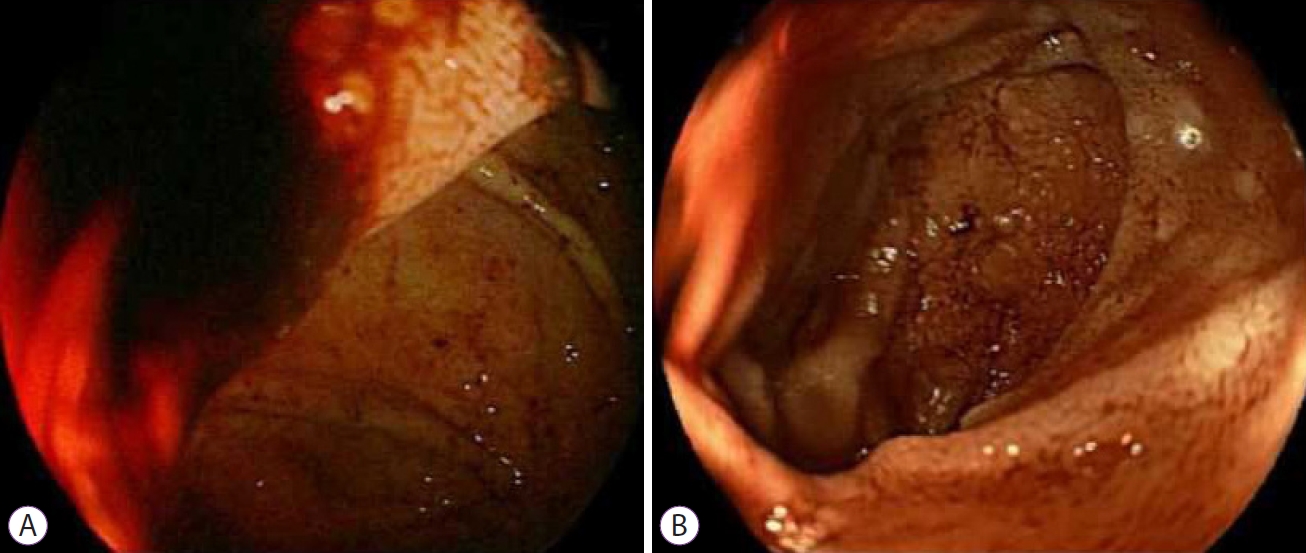
-
 Abstract
Abstract
 PDF
PDF PubReader
PubReader ePub
ePub - The Roux-en-Y gastric bypass is one of the most extensive surgical treatments for obesity. The treatment of upper gastrointestinal bleeding after Roux-en-Y gastric bypass is complex due to the difficulty of accessing the excluded gastric antrum and duodenal bulb. There is no consensus regarding the management of this complication. While various techniques have been described to access the biliopancreatic limb, double-balloon enteroscopy is the most commonly used. If double-balloon enteroscopy is unavailable, a pediatric colonoscope may be used as an alternative; however, its use in such cases has not been described. We report the case of a 50-year-old male patient who underwent gastric bypass 13 years ago and was admitted for a second episode of upper gastrointestinal bleeding. The initial approach using upper endoscopy, colonoscopy, and abdominal computed tomography angiography did not reveal the cause of gastrointestinal hemorrhage; therefore, an endoscopic study of the biliopancreatic limb was performed using a pediatric colonoscope. A Forrest Ib ulcer was found in the duodenal bulb, and endoscopic therapy was administered. The evolution was found to be satisfactory.
-
Citations
Citations to this article as recorded by- Endoscopic management of postoperative bleeding
Sung Hyeok Ryou, Ki Bae Bang
Clinical Endoscopy.2023; 56(6): 706. CrossRef
- Endoscopic management of postoperative bleeding
- 3,113 View
- 74 Download
- 1 Web of Science
- 1 Crossref

Original Article
- Insufflation of Carbon Dioxide versus Air During Colonoscopy Among Pediatric Patients: A Systematic Review and Meta-Analysis of Randomized Controlled Trials
- John Alexander Lata Guacho, Diogo Turiani Hourneaux de Moura, Igor Braga Ribeiro, Bruna Furia Buzetti Hourneaux de Moura, Megui Marilia Mansilla Gallegos, Thomas McCarty, Ricardo Katsuya Toma, Eduardo Guimarães Hourneaux de Moura
- Clin Endosc 2021;54(2):242-249. Published online March 25, 2021
- DOI: https://doi.org/10.5946/ce.2020.275
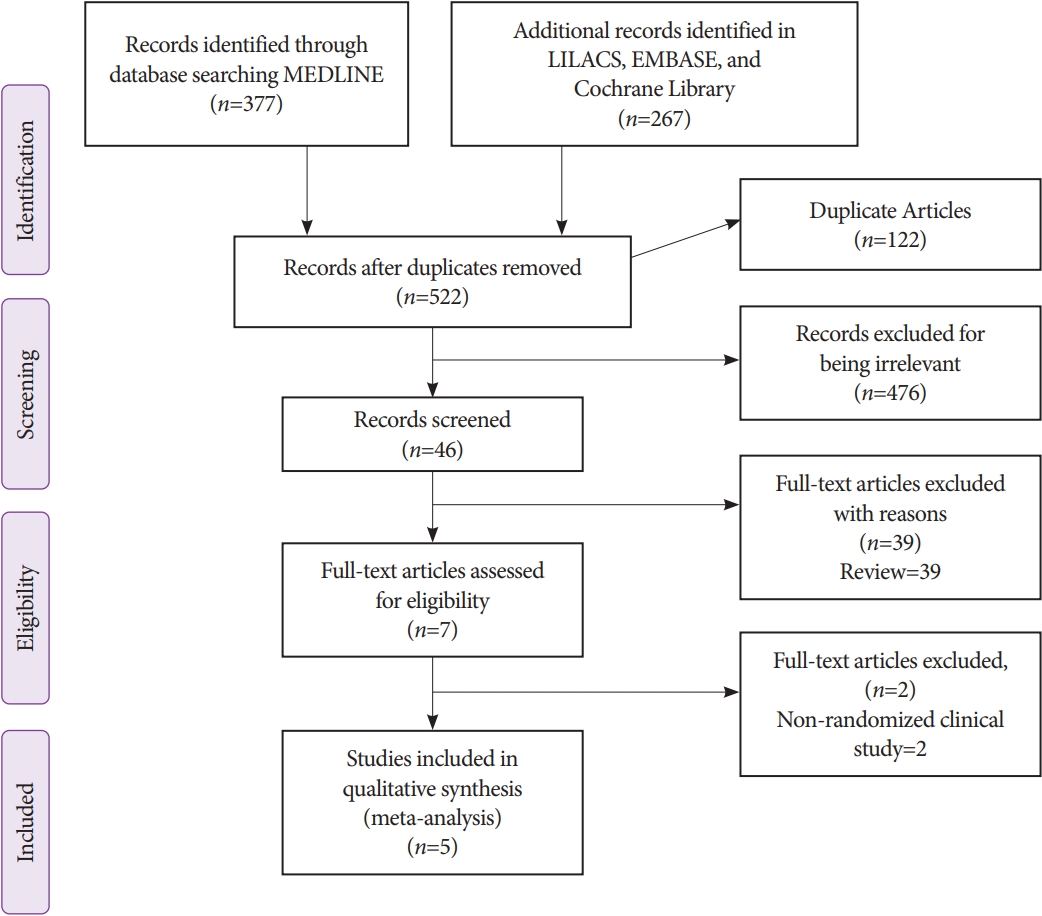
-
 Abstract
Abstract
 PDF
PDF Supplementary Material
Supplementary Material PubReader
PubReader ePub
ePub - Background
/Aims: Carbon dioxide is increasingly used in insufflation during colonoscopy in adult patients; however, air insufflation remains the primary practice among pediatric gastroenterologists. This systematic review and meta-analysis aims to evaluate insufflation using CO2 versus air in colonoscopies in pediatric patients.
Methods
Individualized search strategies were performed using MEDLINE, Cochrane Library, EMBASE, and LILACS databases following Preferred Reporting Items for Systematic Reviews and Meta-Analyses (PRISMA) guidelines and Cochrane working methodology. Randomized control trials (RCTs) were selected for the present meta-analysis. Pooled proportions were calculated for outcomes including procedure time and abdominal pain immediately and 24 hours post-procedure.
Results
The initial search yielded 644 records, of which five RCTs with a total of 358 patients (CO2: n=178 versus air: n=180) were included in the final analysis. The procedure time was not different between the CO2 and air insufflation groups (mean difference, 10.84; 95% confidence interval [CI], -2.55 to 24.22; p=0.11). Abdominal pain immediately post-procedure was significantly lower in the CO2 group (risk difference, -0.15; 95% CI; -0.26 to -0.03; p=0.01) while abdominal pain at 24 hours post-procedure was similar (risk difference, -0.05; 95% CI; -0.11 to 0.01; p=0.11).
Conclusions
Based on this systematic review and meta-analysis of RCT data, CO2 insufflation reduced abdominal pain immediately following the procedure, while pain was similar at 24 hours post-procedure. These results suggest that CO2 is a preferred insufflation technique when performing colonoscopy in pediatric patients. -
Citations
Citations to this article as recorded by- Elevations in End-Tidal CO2 With CO2 Use During Pediatric Endoscopy With Airway Protection: Is This Physiologically Significant?
Chinenye R. Dike, Andrew Huang Pacheco, Elizabeth Lyden, David Freestone, Ojasvini Choudhry, Warren P. Bishop, Mohanad Shukry
Journal of Pediatric Gastroenterology & Nutrition.2023; 76(5): 660. CrossRef
- Elevations in End-Tidal CO2 With CO2 Use During Pediatric Endoscopy With Airway Protection: Is This Physiologically Significant?
- 5,244 View
- 150 Download
- 1 Web of Science
- 1 Crossref

Review
- Current Status of Colorectal Cancer and Its Public Health Burden in Thailand
- Kasenee Tiankanon, Satimai Aniwan, Rungsun Rerknimitr
- Clin Endosc 2021;54(4):499-504. Published online March 15, 2021
- DOI: https://doi.org/10.5946/ce.2020.245-IDEN
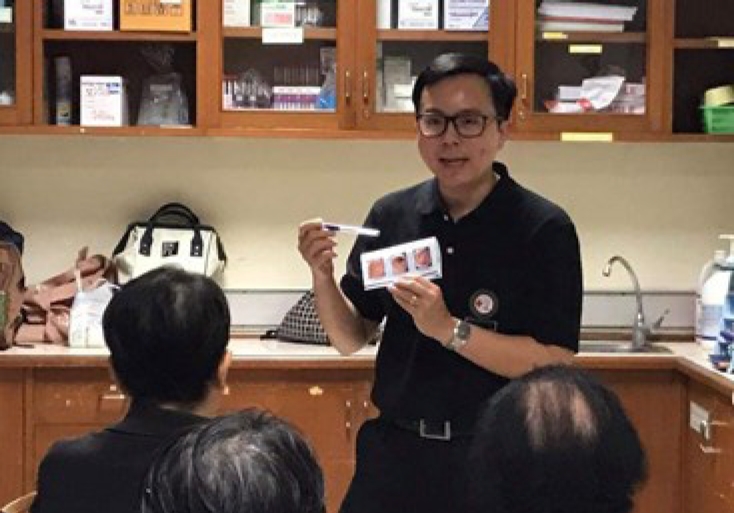
-
 Abstract
Abstract
 PDF
PDF PubReader
PubReader ePub
ePub - Colorectal cancer (CRC) accounts for approximately 10.3% of new cancer cases in Thailand and is currently the 3rd most prevalent cancer found among the Thai population. Starting in 2017, the Thai government announced the national CRC screening program as a response to this important issue. Among the 70 million people currently residing in Thailand, 14 million require screening, while there are approximately a total of 1,000 endoscopists available to perform colonoscopy. Due to the limited resources and shortage of endoscopists in Thailand, applying a population-based one-step colonoscopy program as a primary screening method is not feasible. To reduce colonoscopy workload, with the help of others, including village health volunteers, institution-based health personnel, reimbursement coders, pathologists, and patients due for CRC screening, a two-step approach of one-time fecal immunochemical test (FIT), which prioritizes and filters out subjects for colonoscopy, is chosen. Moreover, additional adjustments to the optimal FIT cutoff value and the modified Asia-Pacific Colorectal Screening risk score, including body weight, were proposed to stratify the priority of colonoscopy schedule. This article aims to give an overview of the past and current policy developmental strategies and the current status of the Thailand CRC screening program.
-
Citations
Citations to this article as recorded by- Integrated Care Model by the Village Health Volunteers to Prevent and Slow down Progression of Chronic Kidney Disease in a Rural Community, Thailand
Ampornpan Theeranut, Nonglak Methakanjanasak, Sunee Lertsinudom, Pattama Surit, Nichanun Panyaek, Saisamon Leeladapattarakul, Peangtikumporn Nilpetch, Pattapong Kessomboon, Chalongchai Chalermwat, Watcharapong Rintara, Wudipong Khongtong, Pawich Paktipat,
Journal of Primary Care & Community Health.2024;[Epub] CrossRef - Dynamics of colorectal cancer screening in low and middle-income countries: A modeling analysis from Thailand
Peeradon Wongseree, Zeynep Hasgul, Borwornsom Leerapan, Cherdsak Iramaneerat, Pochamana Phisalprapa, Mohammad S. Jalali
Preventive Medicine.2023; 175: 107694. CrossRef - An Assessment of Physicians’ Recommendations for Colorectal Cancer Screening and International Guidelines Awareness and Adherence: Results From a Thai National Survey
Nonthalee Pausawasdi, Pongkamon Tongpong, Tanawat Geeratragool, Phunchai Charatcharoenwitthaya
Frontiers in Medicine.2022;[Epub] CrossRef - Cytotoxic effect of metformin on butyrate-resistant PMF-K014 colorectal cancer spheroid cells
Kesara Nittayaboon, Kittinun Leetanaporn, Surasak Sangkhathat, Sittirak Roytrakul, Raphatphorn Navakanitworakul
Biomedicine & Pharmacotherapy.2022; 151: 113214. CrossRef
- Integrated Care Model by the Village Health Volunteers to Prevent and Slow down Progression of Chronic Kidney Disease in a Rural Community, Thailand
- 5,165 View
- 168 Download
- 5 Web of Science
- 4 Crossref

Case Report
- Development of colon cancer in a patient with longstanding colonic diffuse ganglioneuromatosis: a case report
- Jin Sun Oh, Seung Wook Hong, Jin Hee Noh, Jiyoung Yoon, Hyo Jeong Kang, Young Soo Park, Dong-Hoon Yang, Jeong-Sik Byeon
- Clin Endosc 2022;55(3):452-457. Published online March 4, 2021
- DOI: https://doi.org/10.5946/ce.2021.013
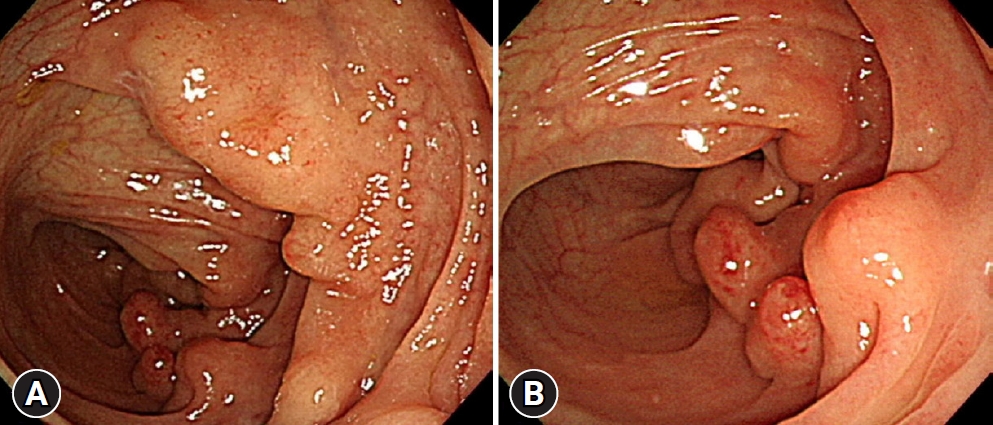
-
 Abstract
Abstract
 PDF
PDF PubReader
PubReader ePub
ePub - Colonic diffuse ganglioneuromatosis is an extremely rare disease in which multiple tumors derived from the ganglion cells, nerve fibers, and supporting cells are distributed in the colon. It is generally considered to be a benign neoplastic condition and is occasionally associated with rare hereditary conditions such as neurofibromatosis type I or multiple endocrine neoplasia type 2B. Here, we report a case of a patient in whom colon cancer developed 12 years after the initial diagnosis of colonic diffuse ganglioneuromatosis, which suggests a possible association between colonic diffuse ganglioneuromatosis and colorectal cancer.
-
Citations
Citations to this article as recorded by- A Case Series of Pediatric Intestinal Ganglioneuromatosis With Novel Phenotypic and Genotypic Profile
Yuan Fang, Ye Zhang, Rui Dong, Yi-zhen Wang, Lian Chen, Gong Chen
Frontiers in Medicine.2022;[Epub] CrossRef
- A Case Series of Pediatric Intestinal Ganglioneuromatosis With Novel Phenotypic and Genotypic Profile
- 3,813 View
- 130 Download
- 1 Web of Science
- 1 Crossref

Review
- Artificial Intelligence in Lower Gastrointestinal Endoscopy: The Current Status and Future Perspective
- Sebastian Manuel Milluzzo, Paola Cesaro, Leonardo Minelli Grazioli, Nicola Olivari, Cristiano Spada
- Clin Endosc 2021;54(3):329-339. Published online January 13, 2021
- DOI: https://doi.org/10.5946/ce.2020.082
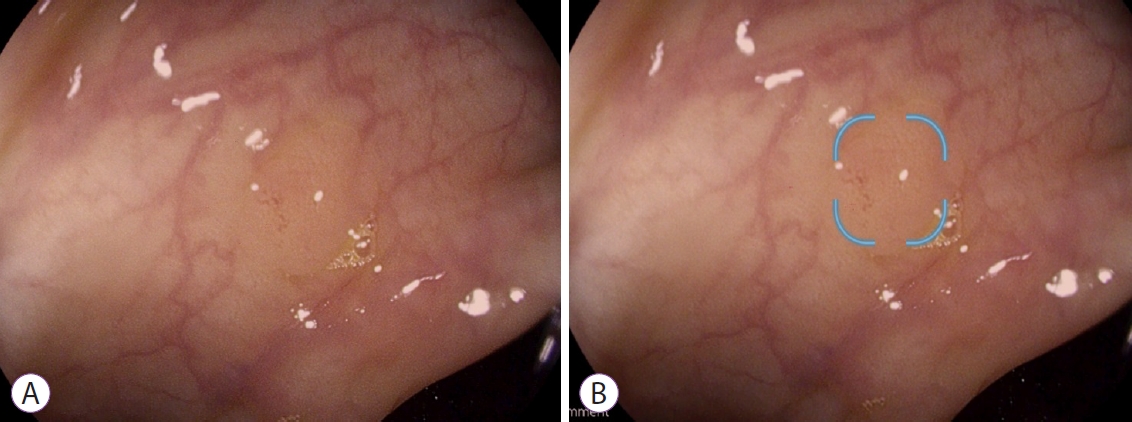
-
 Abstract
Abstract
 PDF
PDF PubReader
PubReader ePub
ePub - The present manuscript aims to review the history, recent advances, evidence, and challenges of artificial intelligence (AI) in colonoscopy. Although it is mainly focused on polyp detection and characterization, it also considers other potential applications (i.e., inflammatory bowel disease) and future perspectives. Some of the most recent algorithms show promising results that are similar to human expert performance. The integration of AI in routine clinical practice will be challenging, with significant issues to overcome (i.e., regulatory, reimbursement). Medico-legal issues will also need to be addressed. With the exception of an AI system that is already available in selected countries (GI Genius; Medtronic, Minneapolis, MN, USA), the majority of the technology is still in its infancy and has not yet been proven to reach a sufficient diagnostic performance to be adopted in the clinical practice. However, larger players will enter the arena of AI in the next few months.
-
Citations
Citations to this article as recorded by- “AI for the new GI”: What role does artificial intelligence have in early colonoscopy training?
Lawrence Hookey
Gastrointestinal Endoscopy.2024; 99(1): 100. CrossRef - Colonoscopy Quality, Innovation, and the Assessment of New Technology
Sanjay R.V. Gadi, Sriya S. Muralidharan, Jeremy R. Glissen Brown
Techniques and Innovations in Gastrointestinal Endoscopy.2024; 26(2): 177. CrossRef - GI genius endoscopy module: a clinical profile
Alberto Savino, Emanuele Rondonotti, Simone Rocchetto, Alessandra Piagnani, Niccolò Bina, Pasquale Di Domenico, Francesco Segatta, Franco Radaelli
Expert Review of Medical Devices.2024; 21(5): 359. CrossRef - Real-time artificial intelligence (AI)-aided endoscopy improves adenoma detection rates even in experienced endoscopists: a cohort study in Singapore
Frederick H. Koh, Jasmine Ladlad, Fung-Joon Foo, Winson J. Tan, Sharmini S. Sivarajah, Leonard M. L. Ho, Jia-Lin Ng, Frederick H. Koh, Cheryl Chong, Darius Aw, Juinn-Haur Kam, Alvin Y. H. Tan, Choon-Chieh Tan, Baldwin P. M. Yeung, Wai-Keong Wong, Bin-Chet
Surgical Endoscopy.2023; 37(1): 165. CrossRef - Systematic meta-analysis of computer-aided detection to detect early esophageal cancer using hyperspectral imaging
Wei-Chih Liao, Arvind Mukundan, Cleorita Sadiaza, Yu-Ming Tsao, Chien-Wei Huang, Hsiang-Chen Wang
Biomedical Optics Express.2023; 14(8): 4383. CrossRef - Detecting colorectal lesions with image-enhanced endoscopy: an updated review from clinical trials
Mizuki Nagai, Sho Suzuki, Yohei Minato, Fumiaki Ishibashi, Kentaro Mochida, Ken Ohata, Tetsuo Morishita
Clinical Endoscopy.2023; 56(5): 553. CrossRef - Accuracy of polyp characterization by artificial intelligence and endoscopists: a prospective, non-randomized study in a tertiary endoscopy center
Sebastian Baumer, Kilian Streicher, Saleh A. Alqahtani, Dominic Brookman-Amissah, Monika Brunner, Christoph Federle, Klaus Muehlenberg, Lukas Pfeifer, Andrea Salzberger, Wolfgang Schorr, Jozef Zustin, Oliver Pech
Endoscopy International Open.2023; 11(09): E818. CrossRef - AI-powered medical devices for practical clinicians including the diagnosis of colorectal polyps
Donghwan Kim, Eunsun Kim
Journal of the Korean Medical Association.2023; 66(11): 658. CrossRef - Artificial Intelligence in Colonoscopic Polyp Detection and Characterization: Merging Computer Technology and Endoscopic Skill for Better Patient Care
Uday C. Ghoshal, Saikat Chakrabarti, Mahesh K. Goenka
Journal of Digestive Endoscopy.2023; 14(04): 239. CrossRef - Diagnostic accuracy of a novel artificial intelligence system for adenoma detection in daily practice: a prospective nonrandomized comparative study
Carolin Zippelius, Saleh A. Alqahtani, Jörg Schedel, Dominic Brookman-Amissah, Klaus Muehlenberg, Christoph Federle, Andrea Salzberger, Wolfgang Schorr, Oliver Pech
Endoscopy.2022; 54(05): 465. CrossRef - Development and validation of a deep learning-based algorithm for colonoscopy quality assessment
Yuan-Yen Chang, Pai-Chi Li, Ruey-Feng Chang, Yu-Yao Chang, Siou-Ping Huang, Yang-Yuan Chen, Wen-Yen Chang, Hsu-Heng Yen
Surgical Endoscopy.2022; 36(9): 6446. CrossRef - Innovation in Gastroenterology—Can We Do Better?
Eyal Klang, Shelly Soffer, Abraham Tsur, Eyal Shachar, Adi Lahat
Biomimetics.2022; 7(1): 33. CrossRef - Hybrid and Deep Learning Approach for Early Diagnosis of Lower Gastrointestinal Diseases
Suliman Mohamed Fati, Ebrahim Mohammed Senan, Ahmad Taher Azar
Sensors.2022; 22(11): 4079. CrossRef - No-Code Platform-Based Deep-Learning Models for Prediction of Colorectal Polyp Histology from White-Light Endoscopy Images: Development and Performance Verification
Eun Jeong Gong, Chang Seok Bang, Jae Jun Lee, Seung In Seo, Young Joo Yang, Gwang Ho Baik, Jong Wook Kim
Journal of Personalized Medicine.2022; 12(6): 963. CrossRef - Impact of the Volume and Distribution of Training Datasets in the Development of Deep-Learning Models for the Diagnosis of Colorectal Polyps in Endoscopy Images
Eun Jeong Gong, Chang Seok Bang, Jae Jun Lee, Young Joo Yang, Gwang Ho Baik
Journal of Personalized Medicine.2022; 12(9): 1361. CrossRef - Preparation of image databases for artificial intelligence algorithm development in gastrointestinal endoscopy
Chang Bong Yang, Sang Hoon Kim, Yun Jeong Lim
Clinical Endoscopy.2022; 55(5): 594. CrossRef - Artificial Intelligence-Based Colorectal Polyp Histology Prediction: High Accuracy in Larger Polyps
Naoki Muguruma, Tetsuji Takayama
Clinical Endoscopy.2022; 55(1): 45. CrossRef - Artificial Intelligence and Advanced Melanoma: Treatment Management Implications
Antonino Guerrisi, Italia Falcone, Fabio Valenti, Marco Rao, Enzo Gallo, Sara Ungania, Maria Teresa Maccallini, Maurizio Fanciulli, Pasquale Frascione, Aldo Morrone, Mauro Caterino
Cells.2022; 11(24): 3965. CrossRef - Clinical feasibility of panintestinal (or panenteric) capsule endoscopy: a systematic review
Pablo Cortegoso Valdivia, Alfonso Elosua, Charles Houdeville, Marco Pennazio, Ignacio Fernández-Urién, Xavier Dray, Ervin Toth, Rami Eliakim, Anastasios Koulaouzidis
European Journal of Gastroenterology & Hepatology.2021; 33(7): 949. CrossRef - Predictors of Positive Video Capsule Endoscopy Findings for Chronic Unexplained Abdominal Pain: Single-Center Retrospective Study and Meta-Analysis
Wonshik Kim, Beomjae Lee, Ahyoung Yoo, Seunghan Kim, Moonkyung Joo, Jong-Jae Park
Diagnostics.2021; 11(11): 2123. CrossRef
- “AI for the new GI”: What role does artificial intelligence have in early colonoscopy training?
- 5,182 View
- 254 Download
- 20 Web of Science
- 20 Crossref

Original Article
- Comparative Study of Narrow-Band Imaging and i-scan for Predicting the Histology of Intermediate-to-Large Colorectal Polyps: A Prospective, Randomized Pilot Study
- Joon Seop Lee, Seong Woo Jeon, Yong Hwan Kwon
- Clin Endosc 2021;54(6):881-887. Published online January 6, 2021
- DOI: https://doi.org/10.5946/ce.2020.257
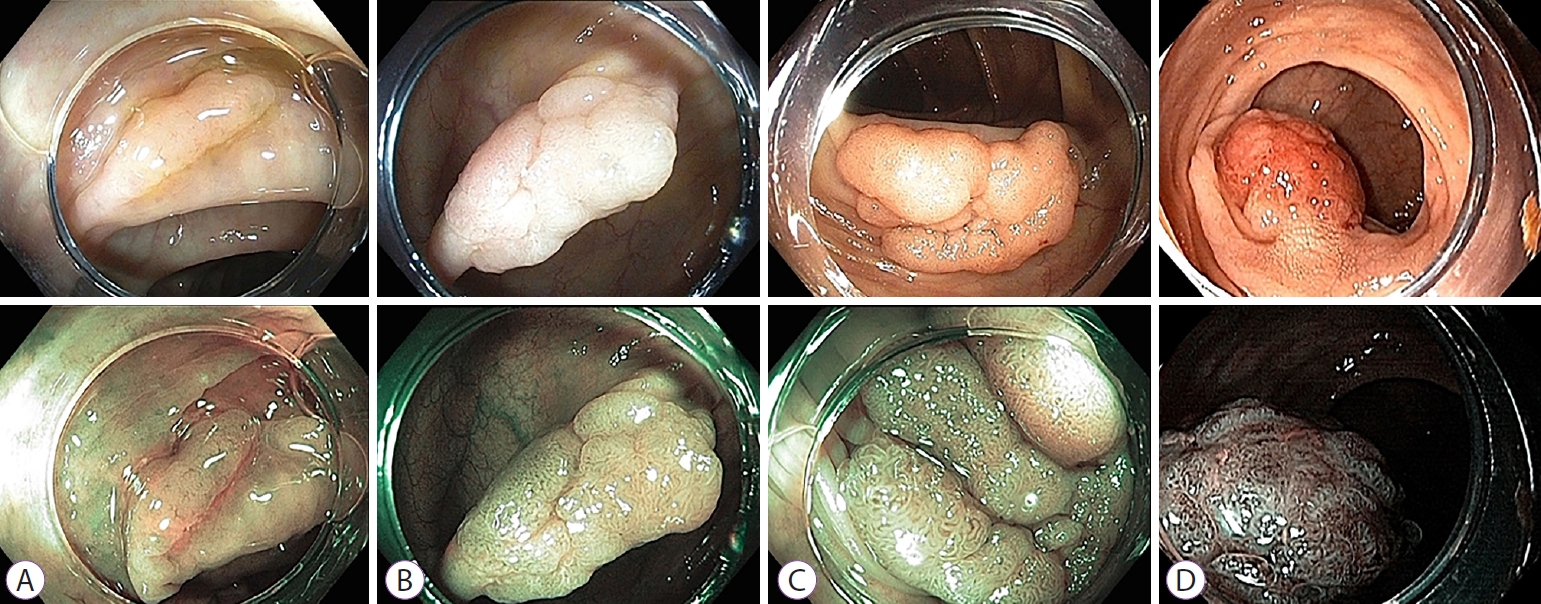
-
 Abstract
Abstract
 PDF
PDF PubReader
PubReader ePub
ePub - Background
/Aims: To date, no reports have compared the diagnostic efficacy of narrow-band imaging (NBI) and i-scan for the histologic prediction of intermediate-to-large colorectal polyps. We aimed to compare the diagnostic accuracy of NBI and i-scan in predicting histology, and their inter-/intra-observer agreement.
Methods
We performed a prospective, randomized study that included 66 patients (NBI, n=33 vs. i-scan, n=33) with colorectal polyps (size >10 mm but <50 mm) who underwent colonoscopic resection. During the procedure, three endoscopists documented their prediction using the Japan NBI Expert Team (JNET) classification. Two months after study completion, the endoscopists reviewed still images and video clips for analysis.
Results
The overall diagnostic accuracies in the NBI and i-scan groups were 73.7% (73/99) and 75.8% (75/99), respectively, and there was no statistical significance between the two groups (p=0.744). The JNET classification as applied to NBI and i-scan showed substantial inter-observer agreement (NBI κ-value 0.612, p=0.001 vs. i-scan κ-value 0.662, p=0.002). Additionally, the κ-values of intra-observer agreement were in the range of 0.385–0.660 with NBI and 0.364–0.741 with i-scan.
Conclusions
NBI and i-scan have similar diagnostic accuracies for the histologic prediction of intermediate-to-large colorectal polyps. Furthermore, the inter-/intra-observer agreement was acceptable for both modalities when the JNET classification was applied. -
Citations
Citations to this article as recorded by- Ultra-minimally invasive endoscopic techniques and colorectal diseases: Current status and its future
Nalini Kanta Ghosh, Ashok Kumar
Artificial Intelligence in Gastrointestinal Endoscopy.2024;[Epub] CrossRef - The Utility of Narrow-Band Imaging International Colorectal Endoscopic Classification in Predicting the Histologies of Diminutive Colorectal Polyps Using I-Scan Optical Enhancement: A Prospective Study
Yeo Wool Kang, Jong Hoon Lee, Jong Yoon Lee
Diagnostics.2023; 13(16): 2720. CrossRef - Detecting colorectal lesions with image-enhanced endoscopy: an updated review from clinical trials
Mizuki Nagai, Sho Suzuki, Yohei Minato, Fumiaki Ishibashi, Kentaro Mochida, Ken Ohata, Tetsuo Morishita
Clinical Endoscopy.2023; 56(5): 553. CrossRef - Classification and endoscopic diagnosis of colorectal polyps
Ji Hyun Kim, Sung Chul Park
Journal of the Korean Medical Association.2023; 66(11): 633. CrossRef - Usefulness of optical enhancement endoscopy combined with magnification to improve detection of intestinal metaplasia in the stomach
Sergio Sobrino-Cossío, Oscar Teramoto-Matsubara, Fabian Emura, Raúl Araya, Vítor Arantes, Elymir S. Galvis-García, Marisi Meza-Caballero, Blanca Sinahi García-Aguilar, Arturo Reding-Bernal, Noriya Uedo
Endoscopy International Open.2022; 10(04): E441. CrossRef - Interventions to improve adenoma detection rates for colonoscopy
Aasma Shaukat, Anne Tuskey, Vijaya L. Rao, Jason A. Dominitz, M. Hassan Murad, Rajesh N. Keswani, Fateh Bazerbachi, Lukejohn W. Day
Gastrointestinal Endoscopy.2022; 96(2): 171. CrossRef - A modified fujinon intelligent color enhancement (FICE) in the diagnostics of superficial epithelial neoplasms of the colon
V. A. Duvanskiy, A. V. Belkov
Experimental and Clinical Gastroenterology.2022; (5): 154. CrossRef - Mucosal imaging in colon polyps: New advances and what the future may hold
Edward John Young, Arvinf Rajandran, Hamish Lachlan Philpott, Dharshan Sathananthan, Sophie Fenella Hoile, Rajvinder Singh
World Journal of Gastroenterology.2022; 28(47): 6632. CrossRef - Commentary on “Comparative Study of Narrow-Band Imaging and i-scan for Predicting the Histology of Intermediate-to-Large Colorectal Polyps: A Prospective, Randomized Pilot Study”
Yunho Jung, Masayuki Kato
Clinical Endoscopy.2021; 54(6): 781. CrossRef
- Ultra-minimally invasive endoscopic techniques and colorectal diseases: Current status and its future
- 4,427 View
- 145 Download
- 8 Web of Science
- 9 Crossref

Case Reports
- Fatal Necrotizing Fasciitis Following Uncomplicated Colonoscopic Polypectomy: A Case Report
- Min Kyu Chae, Sang Youn Shin, Min Seob Kwak, Jin Young Yoon, Ha Il Kim, Jae Myung Cha
- Clin Endosc 2021;54(2):280-284. Published online December 11, 2020
- DOI: https://doi.org/10.5946/ce.2020.117

-
 Abstract
Abstract
 PDF
PDF PubReader
PubReader ePub
ePub - Necrotizing fasciitis (NF) is a life-threatening infection that can be caused by various procedures or surgery and may develop in healthy elderly patients. Here, we report a case of a 66-year-old man with diabetes mellitus who underwent colonoscopic polypectomy, without complications. However, he visited the emergency department 24 hours after the procedure complaining of abdominal pain. Abdominopelvic computed tomography revealed multiple air bubbles in the right lateral abdominal muscles. After a diagnosis of NF was made, immediate surgical debridement was performed. However, despite three sessions of extensive surgical debridement and best supportive care at the intensive care unit, the patient died because of sepsis and NF-associated multiple-organ failure. In conclusion, physicians should pay special attention to the possibility of NF if a patient with risk factors for NF develops sepsis after colonoscopic polypectomy.
- 3,316 View
- 112 Download

- Successful Endoscopic Resection of Residual Colonic Mucosa-Associated Lymphoid Tissue Lymphoma after Polypectomy
- Jeongmin Choi
- Clin Endosc 2021;54(5):759-762. Published online November 6, 2020
- DOI: https://doi.org/10.5946/ce.2020.233
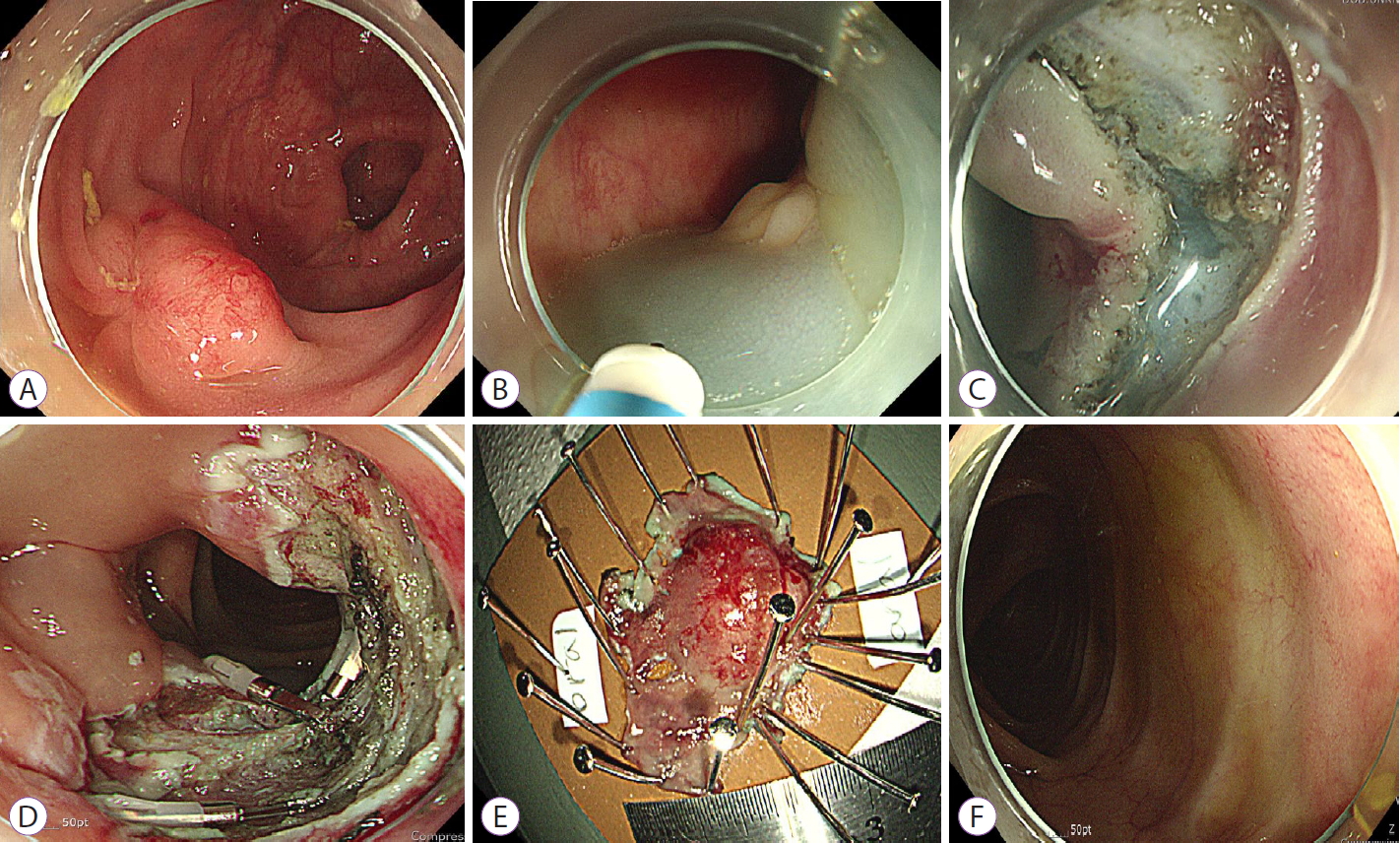
-
 Abstract
Abstract
 PDF
PDF PubReader
PubReader ePub
ePub - Mucosa-associated lymphoid tissue (MALT) lymphomas are typically found in the stomach, while colonic MALT lymphoma is rarely found. Considering its rarity, definitive treatment of colonic MALT lymphoma has not been established. Different from that in the stomach, Helicobacter pylori infection might play a minor role while determining the treatment of colonic MALT lymphoma. If colonic MALT lymphoma is localized, treatment options are surgical resection, radiation, endoscopic resection, or combination therapy. Here, we report a case of residual colonic MALT lymphoma after endoscopic mucosal resection, which was a 1.5-cm-sized tumor confined to the superficial wall of the rectum. The lesion was successfully treated using the endoscopic submucosal dissection technique. The patient remained disease-free for 4 years. This case provides rationale for endoscopic submucosal dissection treatment as a salvage therapy for residual tumors in properly selected patients with colonic MALT lymphoma.
-
Citations
Citations to this article as recorded by- A rare cause of hematochezia: colonic extranodal marginal zone lymphoma of mucosa-associated lymphoid tissue (MALToma): A case report and literature review
Chien-Hung Lu, Wei-Yu Kao, Chun-Chao Chang, Yu-An Kan
Medicine.2023; 102(21): e33869. CrossRef - Mucosa-Associated Lymphoid Tissue (MALT) Lymphoma in the Gastrointestinal Tract in the Modern Era
Eri Ishikawa, Masanao Nakamura, Akira Satou, Kazuyuki Shimada, Shotaro Nakamura
Cancers.2022; 14(2): 446. CrossRef - Successful Endoscopic Resection of Primary Rectal Mucosa-Associated Lymphoid Tissue Lymphoma by Endoscopic Submucosal Dissection: A Case Report
Jian Han, Zhe Zhu, Chao Zhang, Hua-ping Xie
Frontiers in Medicine.2021;[Epub] CrossRef
- A rare cause of hematochezia: colonic extranodal marginal zone lymphoma of mucosa-associated lymphoid tissue (MALToma): A case report and literature review
- 3,969 View
- 100 Download
- 3 Web of Science
- 3 Crossref

-
Underwater Endoscopic Mucosal Resection without Submucosal Injection Facilitates En bloc Resection of Colon Adenomas Extending into a Diverticulum

- Yoshikazu Hayashi, Masahiro Okada, Takaaki Morikawa, Tatsuma Nomura, Hisashi Fukuda, Takahito Takezawa, Alan Kawarai Lefor, Hironori Yamamoto
- Clin Endosc 2021;54(3):436-440. Published online November 6, 2020
- DOI: https://doi.org/10.5946/ce.2020.168
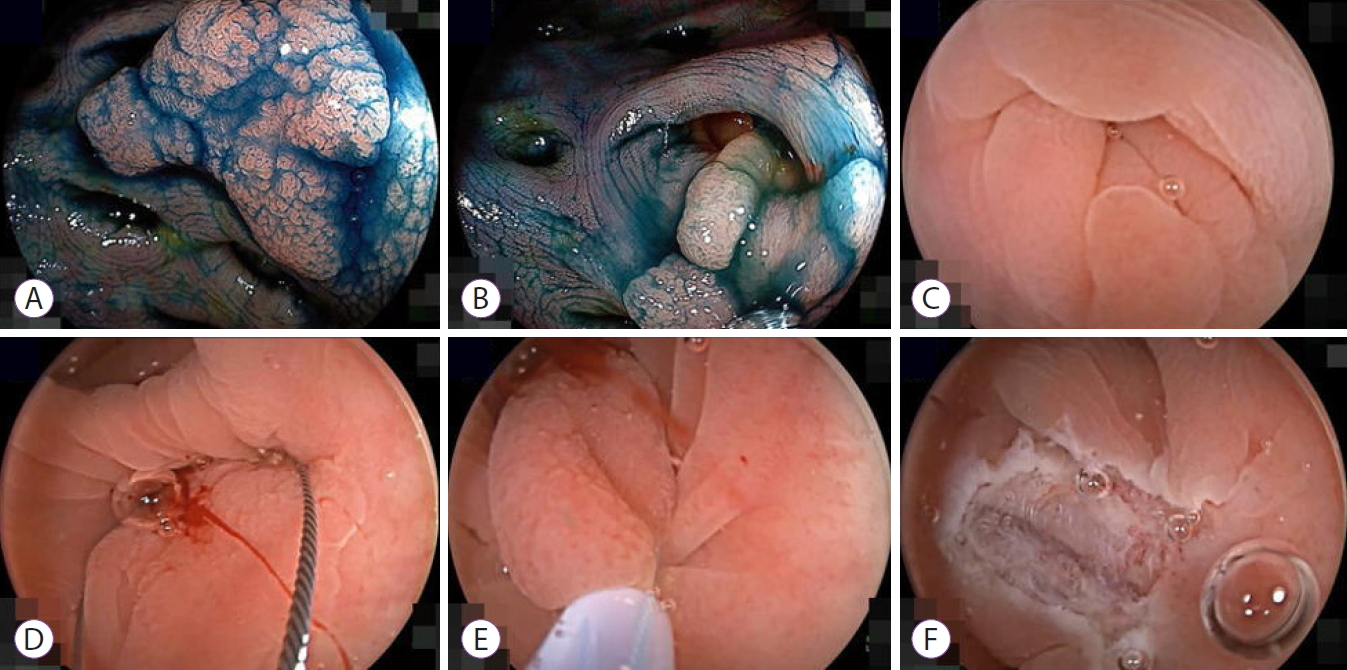
-
 Abstract
Abstract
 PDF
PDF Supplementary Material
Supplementary Material PubReader
PubReader ePub
ePub - Superficial colonic neoplasms sometimes extend into a diverticulum. Conventional endoscopic mucosal resection of these lesions is considered challenging because colonic diverticula do not have a muscularis propria and are deeply inverted. Even if the solution is carefully injected below the mucosa at the bottom of the diverticulum, the mucosa is rarely elevated from the diverticular orifice, and it is usually just narrowed. Although endoscopic submucosal dissection or full-thickness resection with an over-the-scope clip device enables the complete resection of these lesions, it is still challenging, time consuming and expensive. Underwater endoscopic mucosal resection without submucosal injection (UEMR) is an innovative technique enabling en bloc resection of superficial colon lesions. We report three patients with colon adenomas extending into a diverticulum treated with successful UEMR. UEMR enabled rapid and safe en bloc resection of colon lesions extending into a diverticulum.
-
Citations
Citations to this article as recorded by- Underwater endoscopic mucosal resection for colorectal lesions: Can it be an “Underwater” revolution?
Yoji Takeuchi, Satoki Shichijo, Noriya Uedo, Ryu Ishihara
DEN Open.2022;[Epub] CrossRef
- Underwater endoscopic mucosal resection for colorectal lesions: Can it be an “Underwater” revolution?
- 3,777 View
- 111 Download
- 1 Web of Science
- 1 Crossref

Original Article
- Changes in Policy and Endoscopic Procedures during the 2019 Coronavirus Disease Outbreak: A Single Center Experience
- Adi Lahat, Avidan Benjamin
- Clin Endosc 2021;54(1):48-54. Published online November 6, 2020
- DOI: https://doi.org/10.5946/ce.2020.132

-
 Abstract
Abstract
 PDF
PDF PubReader
PubReader ePub
ePub - Background
/Aims: The coronavirus disease-19 (COVID-19) pandemic forced endoscopy units to enact major changes on daily practice and policy. The Chaim Sheba Medical Center is a tertiary referral center located in the center of Israel, and serves cities with high infection rates. Our aim was to review the policies enacted during this outbreak and study their influence on the performance of endoscopic procedures.
Methods
Following the revision of work protocols, personnel were divided into two permanent and physically separate working groups and screening procedures were rescheduled. Relevant data including the number of endoscopic examinations, type of procedure performed, and patient referrals and indications were taken from a computerized database and evaluated. The study included data for January–March 2018–2020, and a comparison among the data from each year was performed.
Results
As of March 2020, the total number of endoscopic examinations performed reduced by 44% (p<0.0001) as compared to previous years, gastroscopy examinations reduced by 39% (p=0.02), and lower endoscopy procedures reduced by 57% (p<0.0001). Meanwhile, the number of advanced endoscopic procedures performed remained consistent with previous years. The indications for performance of gastroscopy and lower endoscopy were different in March 2020, while these remained unchanged for advanced endoscopic procedures.
Conclusions
The current policy appears to serve both our initial goals: protecting personnel and patients’ safety and minimizing potential damage from delayed endoscopic procedures. A longer term follow-up study is needed in order to fully analyze our results. -
Citations
Citations to this article as recorded by- Association of COVID-19 Pandemic with Colorectal Cancer Screening: Impact of Race/Ethnicity and Social Vulnerability
Muhammad Muntazir Mehdi Khan, Muhammad Musaab Munir, Selamawit Woldesenbet, Yutaka Endo, Mujtaba Khalil, Diamantis Tsilimigras, Alan Harzman, Emily Huang, Matthew Kalady, Timothy M. Pawlik
Annals of Surgical Oncology.2024; 31(5): 3222. CrossRef - Setting up a three‐stage pre‐endoscopy triage during the coronavirus disease 2019 pandemic: A multicenter observational study
Tao‐Chieh Liu, Chen‐Ling Peng, Fang‐Yu Hsu, Li‐Chun Chang, Hsiu‐Po Wang, Wei‐Kuo Chang
DEN Open.2023;[Epub] CrossRef - Impact of the COVID-19 Pandemic on Colorectal Cancer Screening: a Systematic Review
Afrooz Mazidimoradi, Azita Tiznobaik, Hamid Salehiniya
Journal of Gastrointestinal Cancer.2022; 53(3): 730. CrossRef - The impact of the COVID-19 pandemic on colorectal and gastric cancer diagnosis, disease stage and mortality
Naim Abu-Freha, Reut Hizkiya, Muhammad Abu-Abed, Tal Michael, Binil Mathew Jacob, Keren Rouvinov, Doron Schwartz, Avraham Reshef, Uri Netz, Ilia Pinsk, Ohad Etzion
Frontiers in Medicine.2022;[Epub] CrossRef - The Dramatic Change in Endoscopic Activities Following the Coronavirus Disease 2019 Outbreak. Is It Evolution?
Kook Hyun Kim
Clinical Endoscopy.2021; 54(3): 445. CrossRef - Protecting Your Endoscopy Unit during the COVID-19 Pandemic
Hyeong Ho Jo, Eun Young Kim
The Korean Journal of Helicobacter and Upper Gastrointestinal Research.2021; 21(3): 239. CrossRef - Capsule Endoscopy in Crohn’s Disease—From a Relative Contraindication to Habitual Monitoring Tool
Adi Lahat, Ido Veisman
Diagnostics.2021; 11(10): 1737. CrossRef
- Association of COVID-19 Pandemic with Colorectal Cancer Screening: Impact of Race/Ethnicity and Social Vulnerability
- 4,968 View
- 123 Download
- 6 Web of Science
- 7 Crossref


 KSGE
KSGE


 First
First Prev
Prev



